| Non-Rationalised NCERT Books Solution | ||||||
|---|---|---|---|---|---|---|
| 6th | 7th | 8th | 9th | 10th | 11th | 12th |
Chapter 6 Triangles
This solutions guide delves into Chapter 6: Triangles, shifting the focus from the concept of congruence (identical shape and size) to the equally important but distinct concept of similarity. While congruence deals with exact replicas, similarity addresses figures that maintain the same shape but may differ in size. This chapter explores the conditions under which triangles are deemed similar, investigates the profound theorems arising from these conditions, and revisits the fundamental Pythagoras theorem, now proving it rigorously using the principles of similarity. Understanding similarity is crucial for scaling geometric figures, analyzing proportions, and solving a wide range of problems in geometry and its applications, such as map-making, engineering design, and perspective drawing.
The journey begins with a precise definition of similar figures and, more specifically, similar triangles. Two triangles are similar if, and only if, two conditions are met simultaneously:
- Their corresponding angles are equal. (e.g., if $\triangle ABC \sim \triangle PQR$, then $\angle A = \angle P$, $\angle B = \angle Q$, $\angle C = \angle R$).
- Their corresponding sides are in the same ratio, meaning they are proportional. (e.g., $\frac{AB}{PQ} = \frac{BC}{QR} = \frac{CA}{RP} = k$, where $k$ is the scale factor).
Establishing similarity doesn't always require checking all angles and all sides. Like congruence criteria, there are specific minimal conditions, known as similarity criteria, that guarantee two triangles are similar. The solutions explain and extensively apply these criteria:
- AA (Angle-Angle) Similarity: If two angles of one triangle are respectively equal to two angles of another triangle, then the two triangles are similar. (The third angles must also be equal due to the angle sum property).
- SAS (Side-Angle-Side) Similarity: If one angle of a triangle is equal to one angle of another triangle and the sides including these angles are proportional, then the triangles are similar.
- SSS (Side-Side-Side) Similarity: If the corresponding sides of two triangles are proportional, then their corresponding angles are equal, and the triangles are similar.
Solutions demonstrate using these criteria to formally prove triangle similarity ($\triangle ABC \sim \triangle PQR$) and subsequently leveraging the properties of similar triangles (equal angles or proportional sides) to deduce unknown lengths or angles.
Two pivotal theorems concerning proportionality within triangles are thoroughly explored:
The Basic Proportionality Theorem (BPT), also known as Thales Theorem, is a cornerstone result. It states that if a line is drawn parallel to one side of a triangle intersecting the other two sides at distinct points, then the line divides the other two sides in the same ratio. Solutions provide detailed proofs and numerous examples showcasing its application in finding segment lengths.
The Converse of BPT is equally important: If a line divides any two sides of a triangle in the same ratio, then the line must be parallel to the third side. Solutions illustrate how this converse is used to prove lines are parallel based on segment ratios.
Furthermore, the relationship between the areas of similar triangles is established through a key theorem: The ratio of the areas of two similar triangles is equal to the square of the ratio of their corresponding sides. This principle extends to other corresponding linear elements like altitudes, medians, and angle bisectors. For instance, if $\triangle ABC \sim \triangle PQR$, then $\frac{Area(\triangle ABC)}{Area(\triangle PQR)} = (\frac{AB}{PQ})^2 = (\frac{BC}{QR})^2 = (\frac{CA}{RP})^2$. Solutions demonstrate the proof and application of this area relationship.
Finally, the chapter provides rigorous proofs for the Pythagoras Theorem (in a right-angled triangle, the square of the hypotenuse is equal to the sum of the squares of the other two sides, $a^2 + b^2 = c^2$) and its Converse, utilizing the concepts of triangle similarity developed earlier. This offers a deeper understanding compared to previous introductions. Extensive practice problems involving right-angled triangles are solved using these theorems. Throughout this chapter's solutions, the emphasis remains firmly on constructing logical proofs and accurately applying the criteria and theorems of similarity.
Exercise 6.1
Question 1. Fill in the blanks using the correct word given in brackets :
(i) All circles are ______________ (congruent, similar)
(ii) All squares are ____________. (similar, congruent)
(iii) All _______________triangles are similar. (isosceles, equilateral)
(iv) Two polygons of the same number of sides are similar, if (a) their corresponding angles are _____________________ and (b) their corresponding sides are ___________ .(equal, proportional)
Answer:
(i) All circles are similar. (congruent, similar)
Explanation:
Two geometric figures are said to be similar if they have the same shape, but not necessarily the same size. Two figures are congruent if they have the same shape and the same size.
All circles have the same shape (a set of points equidistant from a center), but they can have different radii. For example, a circle with a radius of 2 cm and a circle with a radius of 5 cm have the same shape but different sizes. Since they have the same shape, they are similar. They would only be congruent if their radii were equal.
(ii) All squares are similar. (similar, congruent)
Explanation:
A square is a polygon with four equal sides and four equal angles, each being $90^\circ$. Any two squares will have all corresponding angles equal (all are $90^\circ$). The ratio of their corresponding sides will also be constant. For instance, a square of side 2 cm and a square of side 4 cm have corresponding angles of $90^\circ$. The ratio of their corresponding sides is $\frac{4}{2} = 2$. Since they have the same shape (equal corresponding angles and proportional corresponding sides), they are similar. They are not necessarily congruent, as their side lengths can be different.
(iii) All equilateral triangles are similar. (isosceles, equilateral)
Explanation:
An equilateral triangle has all three sides equal and all three angles equal to $60^\circ$. If you take any two equilateral triangles, all their corresponding angles will be equal ($60^\circ = 60^\circ = 60^\circ$). By the AAA (Angle-Angle-Angle) similarity criterion, any two equilateral triangles are similar.
An isosceles triangle only has two equal sides and two equal angles. For example, one isosceles triangle could have angles $50^\circ, 50^\circ, 80^\circ$ and another could have angles $70^\circ, 70^\circ, 40^\circ$. Since their corresponding angles are not equal, they are not similar. Therefore, not all isosceles triangles are similar.
(iv) Two polygons of the same number of sides are similar, if (a) their corresponding angles are equal and (b) their corresponding sides are proportional. (equal, proportional)
Explanation:
This is the formal definition of similar polygons. For two polygons to be similar, both conditions must be met:
(a) Corresponding angles must be equal: This ensures that the polygons have the same shape. For example, a square and a rectangle both have equal angles ($90^\circ$), but they are not necessarily similar.
(b) Corresponding sides must be proportional: This ensures that one polygon is a scaled version of the other. For example, a square and a rhombus can have proportional sides, but if their angles are different, they are not similar.
Therefore, for similarity, angles must be equal, and sides must be in proportion.
Question 2. Give two different examples of pair of
(i) similar figures.
(ii) non-similar figures.
Answer:
Let's provide examples based on the definition of similar figures (same shape, possibly different size) and non-similar figures (different shapes).
(i) Similar figures:
Two figures are similar if they have the same shape but not necessarily the same size. The ratio of corresponding sides is proportional, and corresponding angles are equal.
Example 1: Two circles of different radii. Circles of any size are always round, so they have the same shape. For example, a circle with radius 2 cm and a circle with radius 5 cm are similar.
Example 2: Two squares of different side lengths. All squares have four equal sides and four right angles ($90^\circ$). Their shape is fixed. For example, a square with side length 3 cm and a square with side length 7 cm are similar.
(Other examples include: two equilateral triangles, two photographs of the same scene enlarged or reduced, a map and the actual geographic area it represents).
(ii) Non-similar figures:
Two figures are non-similar if they do not have the same shape.
Example 1: A circle and a square. A circle is round and a square has straight sides and corners. They clearly do not have the same shape.
Example 2: A triangle and a rectangle. A triangle has three sides and three angles, while a rectangle has four sides and four angles. They do not have the same shape.
(Other examples include: a right-angled triangle and an equilateral triangle, a square and a rectangle that is not a square, a circle and a line segment).
Question 3. State whether the following quadrilaterals are similar or not:

Answer:
To determine if the two quadrilaterals, PQRS and ABCD, are similar, we must check the two conditions for the similarity of polygons:
1. The corresponding angles must be equal.
2. The ratio of the lengths of the corresponding sides must be the same (i.e., the sides must be proportional).
Let's examine the two given quadrilaterals.
Quadrilateral ABCD is a square, as all its sides are 3 cm and all its angles are indicated as right angles ($90^\circ$).
So, $\angle A = \angle B = \angle C = \angle D = 90^\circ$.
Quadrilateral PQRS is a rhombus, as all its sides are 1.5 cm. However, from the figure, its angles are not right angles. For example, $\angle P$ is an acute angle and $\angle S$ is an obtuse angle.
Checking the conditions for similarity:
1. Corresponding Sides:
Let's find the ratio of the corresponding sides:
$\frac{AB}{PQ} = \frac{3}{1.5} = 2$
$\frac{BC}{QR} = \frac{3}{1.5} = 2$
$\frac{CD}{RS} = \frac{3}{1.5} = 2$
$\frac{DA}{SP} = \frac{3}{1.5} = 2$
The ratio of the corresponding sides is constant ($\frac{2}{1}$). So, the sides are proportional.
2. Corresponding Angles:
In square ABCD, all angles are $90^\circ$.
In rhombus PQRS, the angles are not $90^\circ$.
Therefore, the corresponding angles are not equal. For example:
$\angle A \neq \angle P$
$\angle B \neq \angle Q$
... and so on.
Conclusion
For two polygons to be similar, both conditions must be satisfied. In this case, although the corresponding sides are proportional, the corresponding angles are not equal.
Therefore, the quadrilaterals PQRS and ABCD are not similar.
Example 1 to 3 (Before Exercise 6.2)
Example 1. If a line intersects sides AB and AC of a ∆ ABC at D and E respectively and is parallel to BC, prove that $\frac{AD}{AB}$ = $\frac{AE}{AC}$ (see Fig. 6.13).
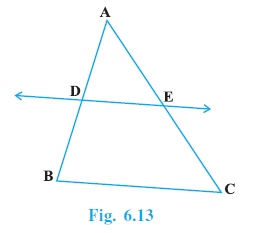
Answer:
Given: In $\triangle ABC$, a line DE intersects AB at D and AC at E such that DE || BC.
To Prove: $\frac{AD}{AB} = \frac{AE}{AC}$.
Proof:
Consider $\triangle ADE$ and $\triangle ABC$.
$\angle ADE = \angle ABC$
(Corresponding angles, since DE || BC and AB is a transversal)
$\angle AED = \angle ACB$
(Corresponding angles, since DE || BC and AC is a transversal)
$\angle DAE = \angle BAC$
(Common angle to both triangles)
Since the corresponding angles of $\triangle ADE$ and $\triangle ABC$ are equal, by AAA similarity criterion, we have:
$\triangle ADE \sim \triangle ABC$.
When two triangles are similar, the ratio of their corresponding sides is equal.
Therefore, we can write:
$\frac{AD}{AB} = \frac{AE}{AC} = \frac{DE}{BC}$.
From the equality of the first two ratios, we get the required result:
$\frac{AD}{AB} = \frac{AE}{AC}$
Hence, proved.
Alternate Proof using Basic Proportionality Theorem (Theorem 6.1):
Given: In $\triangle ABC$, a line DE intersects AB at D and AC at E such that DE || BC.
To Prove: $\frac{AD}{AB} = \frac{AE}{AC}$.
Proof:
Since DE || BC, by the Basic Proportionality Theorem (BPT), also known as Thales' Theorem, if a line is drawn parallel to one side of a triangle to intersect the other two sides in distinct points, the other two sides are divided in the same ratio.
Therefore, we have:
$\frac{AD}{DB} = \frac{AE}{EC}$
(By BPT)
Now, we need to get the ratios $\frac{AD}{AB}$ and $\frac{AE}{AC}$. We can manipulate the equation $\frac{AD}{DB} = \frac{AE}{EC}$.
Take the reciprocal of both sides:
$\frac{DB}{AD} = \frac{EC}{AE}$.
Add 1 to both sides:
$\frac{DB}{AD} + 1 = \frac{EC}{AE} + 1$
$\frac{DB + AD}{AD} = \frac{EC + AE}{AE}$.
From the figure, $DB + AD = AB$ and $EC + AE = AC$. Substitute these into the equation:
$\frac{AB}{AD} = \frac{AC}{AE}$.
Take the reciprocal of both sides again:
$\frac{AD}{AB} = \frac{AE}{AC}$
Hence, proved.
Example 2. ABCD is a trapezium with AB || DC. E and F are points on non-parallel sides AD and BC respectively such that EF is parallel to AB (see Fig. 6.14). Show that $\frac{AE}{ED}$ = $\frac{BF}{FC}$ .
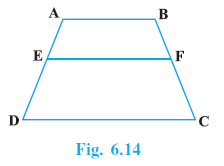
Answer:
Given:
A trapezium ABCD in which $AB \parallel DC$.
E and F are points on the non-parallel sides AD and BC respectively such that $EF \parallel AB$.
Since $EF \parallel AB$ and $AB \parallel DC$, it follows that $AB \parallel EF \parallel DC$. (Lines parallel to the same line are parallel to each other).
To Prove:
$\frac{AE}{ED} = \frac{BF}{FC}$
Construction:
Join AC to intersect EF at point G.
Proof:
In $\triangle ADC$, we have $EG \parallel DC$ (since $EF \parallel DC$).
By the Basic Proportionality Theorem (BPT) or Thales' Theorem, if a line is drawn parallel to one side of a triangle intersecting the other two sides, then it divides the two sides proportionally.
Therefore, in $\triangle ADC$:
$\frac{AE}{ED} = \frac{AG}{GC}$
[By BPT] ... (i)
Now, consider $\triangle CAB$. We have $GF \parallel AB$ (since $EF \parallel AB$).
Applying the BPT in $\triangle CAB$:
$\frac{CG}{GA} = \frac{CF}{FB}$
[By BPT]
By taking the reciprocal of the above equation, we get:
$\frac{AG}{GC} = \frac{BF}{FC}$
... (ii)
From equations (i) and (ii), we can equate the expressions:
$\frac{AE}{ED} = \frac{BF}{FC}$
Hence Proved.
Alternate Solution:
Construction:
Join BD to intersect EF at point H.
Proof:
In $\triangle DAB$, we have $EH \parallel AB$ (since $EF \parallel AB$).
By the Basic Proportionality Theorem (BPT):
$\frac{DE}{EA} = \frac{DH}{HB}$
[By BPT]
Taking the reciprocal of the above equation:
$\frac{AE}{ED} = \frac{HB}{DH}$
... (iii)
Now, consider $\triangle BDC$. We have $HF \parallel DC$ (since $EF \parallel DC$).
By the Basic Proportionality Theorem (BPT):
$\frac{BH}{HD} = \frac{BF}{FC}$
[By BPT] ... (iv)
From equation (iii) and equation (iv), we get:
$\frac{AE}{ED} = \frac{BF}{FC}$
Hence Proved.
Example 3. In Fig. 6.16, $\frac{PS}{SQ}$ = $\frac{PT}{TR}$ and ∠PST = ∠PRQ. Prove that PQR is an isosceles triangle.
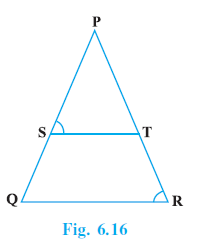
Answer:
Given:
In $\triangle PQR$, points S and T are on sides PQ and PR respectively such that:
$\frac{PS}{SQ} = \frac{PT}{TR}$
(Given ratio)
$\angle PST = \angle PRQ$
(Given angles)
To Prove:
$\triangle PQR$ is an isosceles triangle.
Proof:
We are given that in $\triangle PQR$,
$\frac{PS}{SQ} = \frac{PT}{TR}$
(Given)
According to the Converse of the Basic Proportionality Theorem (BPT) (also known as Thales' Theorem), if a line divides any two sides of a triangle in the same ratio, then the line must be parallel to the third side.
Applying this theorem to $\triangle PQR$, since $\frac{PS}{SQ} = \frac{PT}{TR}$, we can conclude that:
$ST \parallel QR$
Now, consider the parallel lines $ST$ and $QR$ intersected by the transversal line $PQ$. The corresponding angles formed must be equal.
$\angle PST = \angle PQR$
[Corresponding angles] ... (i)
We are also given that:
$\angle PST = \angle PRQ$
[Given] ... (ii)
From equations (i) and (ii), we can equate the values of $\angle PST$:
$\angle PQR = \angle PRQ$
Now, consider $\triangle PQR$. We have found that two of its angles, $\angle PQR$ and $\angle PRQ$, are equal.
In a triangle, sides opposite to equal angles are equal in length.
Therefore, the side opposite to $\angle PRQ$ (which is PQ) must be equal to the side opposite to $\angle PQR$ (which is PR).
$PQ = PR$
A triangle with two equal sides is defined as an isosceles triangle.
Thus, $\triangle PQR$ is an isosceles triangle.
Hence Proved.
Exercise 6.2
Question 1. In Fig. 6.17, (i) and (ii), DE || BC. Find EC in (i) and AD in (ii).
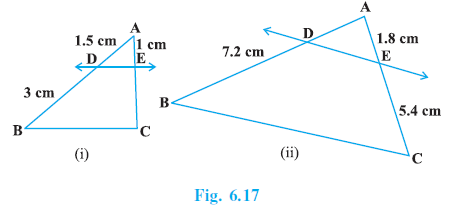
Answer:
Solution for (i)
Given:
In $\triangle ABC$, the line segment DE is parallel to the side BC ($DE \parallel BC$).
$AD = 1.5$ cm
$DB = 3$ cm
$AE = 1$ cm
To Find:
The length of EC.
Solution:
In $\triangle ABC$, we are given that $DE \parallel BC$.
By the Basic Proportionality Theorem (BPT), also known as Thales' Theorem, if a line is drawn parallel to one side of a triangle intersecting the other two sides in distinct points, then the other two sides are divided in the same ratio.
Therefore, we have:
$\frac{AD}{DB} = \frac{AE}{EC}$
[By BPT]
Substitute the given values into the equation:
$\frac{1.5}{3} = \frac{1}{EC}$
Now, we solve for EC:
$1.5 \times EC = 3 \times 1$
$1.5 \times EC = 3$
$EC = \frac{3}{1.5}$
$EC = \frac{30}{15}$
$EC = 2$
Thus, the length of EC is 2 cm.
Solution for (ii)
Given:
In $\triangle ABC$, the line segment DE is parallel to the side BC ($DE \parallel BC$).
$DB = 7.2$ cm
$AE = 1.8$ cm
$EC = 5.4$ cm
To Find:
The length of AD.
Solution:
In $\triangle ABC$, we are given that $DE \parallel BC$.
By the Basic Proportionality Theorem (BPT) or Thales' Theorem:
$\frac{AD}{DB} = \frac{AE}{EC}$
[By BPT]
Substitute the given values into the equation:
$\frac{AD}{7.2} = \frac{1.8}{5.4}$
Now, we solve for AD:
$AD = \frac{1.8}{5.4} \times 7.2$
Simplify the fraction $\frac{1.8}{5.4}$:
$\frac{1.8}{5.4} = \frac{18}{54} = \frac{\cancel{18}^{1}}{\cancel{54}_{3}} = \frac{1}{3}$
Substitute this back into the equation for AD:
$AD = \frac{1}{3} \times 7.2$
$AD = \frac{7.2}{3}$
$AD = 2.4$
Thus, the length of AD is 2.4 cm.
Question 2. E and F are points on the sides PQ and PR respectively of a ∆ PQR. For each of the following cases, state whether EF || QR :
(i) PE = 3.9 cm, EQ = 3 cm, PF = 3.6 cm and FR = 2.4 cm
(ii) PE = 4 cm, QE = 4.5 cm, PF = 8 cm and RF = 9 cm
(iii) PQ = 1.28 cm, PR = 2.56 cm, PE = 0.18 cm and PF = 0.36 cm
Answer:
To determine if EF is parallel to QR (EF || QR) in $\triangle PQR$, we use the Converse of the Basic Proportionality Theorem (BPT).
The theorem states: If a line divides any two sides of a triangle in the same ratio, then the line is parallel to the third side.
For each case, we will check if the line segment EF divides the sides PQ and PR in the same ratio. That is, we will check if $\frac{PE}{EQ} = \frac{PF}{FR}$. If the ratios are equal, then EF || QR.
(i) PE = 3.9 cm, EQ = 3 cm, PF = 3.6 cm and FR = 2.4 cm
Solution:
We calculate the ratio of the segments on side PQ:
$\frac{PE}{EQ} = \frac{3.9}{3} = \frac{39}{30} = \frac{13}{10} = 1.3$
Next, we calculate the ratio of the segments on side PR:
$\frac{PF}{FR} = \frac{3.6}{2.4} = \frac{36}{24} = \frac{3}{2} = 1.5$
Comparing the two ratios:
Since $1.3 \neq 1.5$, we have $\frac{PE}{EQ} \neq \frac{PF}{FR}$.
Therefore, by the Converse of BPT, EF is not parallel to QR.
(ii) PE = 4 cm, QE = 4.5 cm, PF = 8 cm and RF = 9 cm
Solution:
We calculate the ratio of the segments on side PQ:
$\frac{PE}{QE} = \frac{4}{4.5} = \frac{40}{45} = \frac{8}{9}$
Next, we calculate the ratio of the segments on side PR:
$\frac{PF}{RF} = \frac{8}{9}$
Comparing the two ratios:
Since $\frac{PE}{QE} = \frac{PF}{RF} = \frac{8}{9}$, the line EF divides the sides PQ and PR in the same ratio.
Therefore, by the Converse of BPT, EF is parallel to QR.
(iii) PQ = 1.28 cm, PR = 2.56 cm, PE = 0.18 cm and PF = 0.36 cm
Solution:
Here, we are given the lengths of the full sides PQ and PR. First, we find the lengths of the remaining segments, EQ and FR.
$EQ = PQ - PE = 1.28 - 0.18 = 1.10$ cm
$FR = PR - PF = 2.56 - 0.36 = 2.20$ cm
Now, we check the ratio $\frac{PE}{EQ}$:
$\frac{PE}{EQ} = \frac{0.18}{1.10} = \frac{18}{110} = \frac{9}{55}$
And the ratio $\frac{PF}{FR}$:
$\frac{PF}{FR} = \frac{0.36}{2.20} = \frac{36}{220} = \frac{9}{55}$
Since $\frac{PE}{EQ} = \frac{PF}{FR} = \frac{9}{55}$, the sides are divided proportionally.
Therefore, by the Converse of BPT, EF is parallel to QR.
Alternate Solution for (iii):
We can also check the ratio of the upper segments to the full sides. If $\frac{PE}{PQ} = \frac{PF}{PR}$, then EF || QR.
Ratio on side PQ:
$\frac{PE}{PQ} = \frac{0.18}{1.28} = \frac{18}{128} = \frac{9}{64}$
Ratio on side PR:
$\frac{PF}{PR} = \frac{0.36}{2.56} = \frac{36}{256} = \frac{9}{64}$
Since $\frac{PE}{PQ} = \frac{PF}{PR} = \frac{9}{64}$, the condition is satisfied.
Therefore, EF is parallel to QR.
Question 3. In Fig. 6.18, if LM || CB and LN || CD, prove that $\frac{AM}{AB}$ = $\frac{AN}{AD}$ .

Answer:
Given:
In the given figure, we have:
$LM \parallel CB$
$LN \parallel CD$
To Prove:
$\frac{AM}{AB} = \frac{AN}{AD}$
Proof:
First, consider the triangle $\triangle ABC$.
We are given that $LM \parallel CB$.
By the Basic Proportionality Theorem (BPT) or Thales' Theorem, if a line is drawn parallel to one side of a triangle intersecting the other two sides, then it divides the two sides in the same ratio. A corollary of BPT states that the ratio of the parts to the whole sides are also equal.
Applying this corollary in $\triangle ABC$:
$\frac{AM}{AB} = \frac{AL}{AC}$
[Since $LM \parallel CB$] ... (i)
Next, consider the triangle $\triangle ADC$.
We are given that $LN \parallel CD$.
Applying the same corollary of BPT in $\triangle ADC$:
$\frac{AN}{AD} = \frac{AL}{AC}$
[Since $LN \parallel CD$] ... (ii)
From equation (i) and equation (ii), we observe that both $\frac{AM}{AB}$ and $\frac{AN}{AD}$ are equal to the same ratio $\frac{AL}{AC}$.
Therefore, we can equate them:
$\frac{AM}{AB} = \frac{AN}{AD}$
Hence Proved.
Question 4. In Fig. 6.19, DE || AC and DF || AE. Prove that $\frac{BF}{FE}$ = $\frac{BE}{EC}$ .
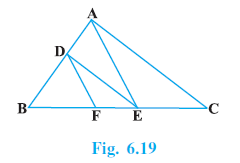
Answer:
Given:
In the given figure (presumably $\triangle ABC$ with points D on AB, E on BC, F on BE):
$DE \parallel AC$
$DF \parallel AE$
To Prove:
$\frac{BF}{FE} = \frac{BE}{EC}$
Proof:
First, consider the triangle $\triangle ABC$.
We are given that $DE \parallel AC$.
By the Basic Proportionality Theorem (BPT) or Thales' Theorem, if a line is drawn parallel to one side of a triangle intersecting the other two sides, then it divides the two sides in the same ratio.
Applying BPT in $\triangle ABC$ (considering line DE intersecting sides AB and BC):
$\frac{BD}{DA} = \frac{BE}{EC}$
[Since $DE \parallel AC$] ... (i)
Next, consider the triangle $\triangle ABE$.
We are given that $DF \parallel AE$.
Applying BPT in $\triangle ABE$ (considering line DF intersecting sides AB and BE):
$\frac{BD}{DA} = \frac{BF}{FE}$
[Since $DF \parallel AE$] ... (ii)
From equation (i) and equation (ii), we observe that both $\frac{BE}{EC}$ and $\frac{BF}{FE}$ are equal to the same ratio $\frac{BD}{DA}$.
Therefore, we can equate them:
$\frac{BF}{FE} = \frac{BE}{EC}$
Hence Proved.
Question 5. In Fig. 6.20, DE || OQ and DF || OR. Show that EF || QR.
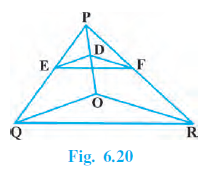
Answer:
Given:
In the given figure (presumably $\triangle PQR$ with point O inside, and points E on PQ, F on PR):
$DE \parallel OQ$
$DF \parallel OR$
To Prove:
$EF \parallel QR$
Proof:
First, consider the triangle $\triangle POQ$.
We are given that $DE \parallel OQ$.
By the Basic Proportionality Theorem (BPT), if a line is drawn parallel to one side of a triangle intersecting the other two sides, then it divides the two sides in the same ratio.
Applying BPT in $\triangle POQ$:
$\frac{PE}{EQ} = \frac{PD}{DO}$
[Since $DE \parallel OQ$] ... (i)
Next, consider the triangle $\triangle POR$.
We are given that $DF \parallel OR$.
Applying BPT in $\triangle POR$:
$\frac{PF}{FR} = \frac{PD}{DO}$
[Since $DF \parallel OR$] ... (ii)
From equation (i) and equation (ii), we observe that both $\frac{PE}{EQ}$ and $\frac{PF}{FR}$ are equal to the same ratio $\frac{PD}{DO}$.
Therefore, we can equate them:
$\frac{PE}{EQ} = \frac{PF}{FR}$
Now, consider the triangle $\triangle PQR$.
We have found that the line segment EF divides the sides PQ and PR in the same ratio, i.e., $\frac{PE}{EQ} = \frac{PF}{FR}$.
By the Converse of the Basic Proportionality Theorem (Converse of BPT), if a line divides any two sides of a triangle in the same ratio, then the line must be parallel to the third side.
Applying the Converse of BPT in $\triangle PQR$:
$EF \parallel QR$
Hence Proved.
Question 6. In Fig. 6.21, A, B and C are points on OP, OQ and OR respectively such that AB || PQ and AC || PR. Show that BC || QR.
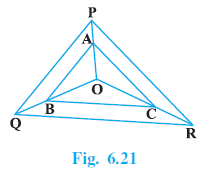
Answer:
Given:
In the given figure:
A is a point on OP.
B is a point on OQ.
C is a point on OR.
$AB \parallel PQ$
$AC \parallel PR$
To Prove:
$BC \parallel QR$
Proof:
First, consider the triangle $\triangle OPQ$.
We are given that $AB \parallel PQ$.
By the Basic Proportionality Theorem (BPT) or Thales' Theorem (using the corollary regarding ratios involving the whole side):
$\frac{OA}{OP} = \frac{OB}{OQ}$
[Since $AB \parallel PQ$] ... (i)
Next, consider the triangle $\triangle OPR$.
We are given that $AC \parallel PR$.
Applying the same corollary of BPT in $\triangle OPR$:
$\frac{OA}{OP} = \frac{OC}{OR}$
[Since $AC \parallel PR$] ... (ii)
From equation (i) and equation (ii), we observe that both $\frac{OB}{OQ}$ and $\frac{OC}{OR}$ are equal to the same ratio $\frac{OA}{OP}$.
Therefore, we can equate them:
$\frac{OB}{OQ} = \frac{OC}{OR}$
Now, consider the triangle $\triangle OQR$.
We have found that the line segment BC divides the sides OQ and OR such that $\frac{OB}{OQ} = \frac{OC}{OR}$.
By the Converse of the Basic Proportionality Theorem (Converse of BPT), if a line divides any two sides of a triangle proportionally (i.e., the ratios $\frac{\text{part}}{\text{whole side}}$ are equal), then the line must be parallel to the third side.
Applying the Converse of BPT (corollary form) in $\triangle OQR$:
Since $\frac{OB}{OQ} = \frac{OC}{OR}$, we conclude that $BC \parallel QR$.
Hence Proved.
Question 7. Using Theorem 6.1, prove that a line drawn through the mid-point of one side of a triangle parallel to another side bisects the third side. (Recall that you have proved it in Class IX).
Answer:
Statement: To prove that a line drawn through the mid-point of one side of a triangle parallel to another side bisects the third side, using Theorem 6.1 (Basic Proportionality Theorem).
Given:
A triangle $\triangle ABC$.
D is the mid-point of side AB. This means $AD = DB$.
A line DE is drawn through D such that $DE \parallel BC$, and DE intersects side AC at point E.
To Prove:
E is the mid-point of side AC. (i.e., $AE = EC$).
Proof:
In $\triangle ABC$, we are given that the line segment DE is drawn parallel to the side BC.
$DE \parallel BC$
[Given]
According to Theorem 6.1 (Basic Proportionality Theorem - BPT), if a line is drawn parallel to one side of a triangle intersecting the other two sides in distinct points, then the other two sides are divided in the same ratio.
Applying BPT to $\triangle ABC$ with $DE \parallel BC$, we get:
$\frac{AD}{DB} = \frac{AE}{EC}$
[By BPT] ... (i)
We are also given that D is the mid-point of side AB.
$AD = DB$
[Given]
Dividing both sides by DB (since $DB \neq 0$), we get:
$\frac{AD}{DB} = 1$
... (ii)
Now, substituting the value from equation (ii) into equation (i):
$1 = \frac{AE}{EC}$
Cross-multiplying, we get:
$AE = EC$
Since AE is equal to EC, the point E divides the side AC into two equal parts.
Therefore, E is the mid-point of the side AC.
This proves that a line drawn through the mid-point of one side of a triangle parallel to another side bisects the third side.
Hence Proved.
Question 8. Using Theorem 6.2, prove that the line joining the mid-points of any two sides of a triangle is parallel to the third side. (Recall that you have done it in Class IX).
Answer:
Statement: To prove that the line joining the mid-points of any two sides of a triangle is parallel to the third side, using Theorem 6.2 (Converse of Basic Proportionality Theorem).
Given:
A triangle $\triangle ABC$.
D is the mid-point of side AB. This means $AD = DB$.
E is the mid-point of side AC. This means $AE = EC$.
DE is the line segment joining the mid-points D and E.
To Prove:
$DE \parallel BC$.
Proof:
Since D is the mid-point of AB, we have:
$AD = DB$
[Definition of mid-point]
Dividing both sides by DB (since $DB \neq 0$), we get:
$\frac{AD}{DB} = 1$
... (i)
Since E is the mid-point of AC, we have:
$AE = EC$
[Definition of mid-point]
Dividing both sides by EC (since $EC \neq 0$), we get:
$\frac{AE}{EC} = 1$
... (ii)
From equation (i) and equation (ii), we can see that:
$\frac{AD}{DB} = \frac{AE}{EC}$
Now, consider the triangle $\triangle ABC$. The line segment DE intersects the sides AB and AC such that it divides these sides in the same ratio.
According to Theorem 6.2 (Converse of the Basic Proportionality Theorem - Converse of BPT), if a line divides any two sides of a triangle in the same ratio, then the line must be parallel to the third side.
Applying Theorem 6.2 to $\triangle ABC$:
Since $\frac{AD}{DB} = \frac{AE}{EC}$, we can conclude that the line segment DE is parallel to the third side BC.
$DE \parallel BC$
This proves that the line joining the mid-points of any two sides of a triangle is parallel to the third side.
Hence Proved.
Question 9. ABCD is a trapezium in which AB || DC and its diagonals intersect each other at the point O. Show that $\frac{AO}{BO}$ = $\frac{CO}{DO}$
Answer:
Given:
A trapezium ABCD in which side $AB$ is parallel to side $DC$ ($AB \parallel DC$).
The diagonals AC and BD intersect each other at the point O.
To Prove:
$\frac{AO}{BO} = \frac{CO}{DO}$
Proof (Using Similar Triangles):
Consider the triangles $\triangle AOB$ and $\triangle COD$.
Since $AB \parallel DC$ and AC is a transversal line:
$\angle OAB = \angle OCD$
[Alternate interior angles]
Since $AB \parallel DC$ and BD is a transversal line:
$\angle OBA = \angle ODC$
[Alternate interior angles]
Also, the angles formed at the intersection O:
$\angle AOB = \angle COD$
[Vertically opposite angles]
Therefore, by the AA (Angle-Angle) similarity criterion (or AAA), the two triangles are similar:
$\triangle AOB \sim \triangle COD$
Since the triangles are similar, the ratio of their corresponding sides must be equal.
$\frac{AO}{CO} = \frac{BO}{DO}$
[Ratio of corresponding sides of similar triangles]
Rearranging the terms by cross-multiplication and then dividing appropriately (or by using the property of alternendo on the proportion):
$AO \times DO = BO \times CO$
$\frac{AO}{BO} = \frac{CO}{DO}$
Hence Proved.
Alternate Proof (Using BPT):
Construction:
Draw a line segment OE through O parallel to AB, such that E lies on AD.
Since $AB \parallel DC$ (Given) and $OE \parallel AB$ (Construction), we have $OE \parallel DC$.
Proof:
Consider $\triangle DAB$. We have $OE \parallel AB$. By the Basic Proportionality Theorem (BPT):
$\frac{DE}{EA} = \frac{DO}{OB}$
[By BPT]
Taking the reciprocal:
$\frac{EA}{DE} = \frac{OB}{DO}$
... (i)
Now consider $\triangle ADC$. We have $OE \parallel DC$. By the BPT:
$\frac{AE}{ED} = \frac{AO}{OC}$
[By BPT] ... (ii)
From equations (i) and (ii), we can equate the expressions:
$\frac{OB}{DO} = \frac{AO}{OC}$
Rearranging the terms:
$\frac{AO}{BO} = \frac{CO}{DO}$
Hence Proved.
Question 10. The diagonals of a quadrilateral ABCD intersect each other at the point O such that $\frac{AO}{BO}$ = $\frac{CO}{DO}$. Show that ABCD is a trapezium.
Answer:
Given:
A quadrilateral ABCD where diagonals AC and BD intersect each other at point O such that:
$\frac{AO}{BO} = \frac{CO}{DO}$
To Prove:
ABCD is a trapezium. (We need to prove that $AB \parallel DC$).
Construction:
Draw a line segment OE through the point O such that OE is parallel to AB, and E lies on the side AD.
Proof:
First, we rearrange the given ratio:
$\frac{AO}{BO} = \frac{CO}{DO}$
[Given]
This can be rewritten as:
$\frac{AO}{CO} = \frac{BO}{DO}$
... (i)
Now, in $\triangle DAB$, by our construction, we have $OE \parallel AB$.
Applying the Basic Proportionality Theorem (BPT) to $\triangle DAB$:
$\frac{DE}{EA} = \frac{DO}{OB}$
[By BPT]
Taking the reciprocal of both sides:
$\frac{AE}{ED} = \frac{BO}{DO}$
... (ii)
From equation (i) and equation (ii), we can see that:
$\frac{AO}{CO} = \frac{BO}{DO}$ and $\frac{AE}{ED} = \frac{BO}{DO}$
Therefore,
$\frac{AE}{ED} = \frac{AO}{CO}$
Now, consider $\triangle ADC$. The line segment OE divides the sides AD and AC in the same ratio ($\frac{AE}{ED} = \frac{AO}{CO}$).
By the Converse of the Basic Proportionality Theorem, if a line divides two sides of a triangle in the same ratio, then the line is parallel to the third side.
Therefore, we can conclude that $OE \parallel DC$.
We have:
$OE \parallel AB$ (By Construction)
$OE \parallel DC$ (Proved above)
Since both AB and DC are parallel to the same line OE, they must be parallel to each other.
$AB \parallel DC$
A quadrilateral with one pair of opposite sides parallel is a trapezium.
Thus, ABCD is a trapezium.
Hence Proved.
Example 4 to 8 (Before Exercise 6.3)
Example 4. In Fig. 6.29, if PQ || RS, prove that ∆ POQ ~ ∆ SOR
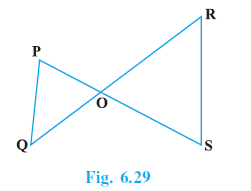
Answer:
Given:
In the given figure, line segment $PQ$ is parallel to line segment $RS$ ($PQ \parallel RS$).
The line segments PS and QR intersect at point O.
To Prove:
$\triangle POQ \sim \triangle SOR$ (Triangle POQ is similar to triangle SOR).
Proof:
To prove that the two triangles are similar, we will use the Angle-Angle (AA) similarity criterion by showing that two pairs of corresponding angles are equal.
Consider the two triangles $\triangle POQ$ and $\triangle SOR$.
Since the lines PQ and RS are parallel and the line PS is a transversal that intersects them:
$\angle OPQ = \angle OSR$
[Pair of alternate interior angles]
Similarly, since the lines PQ and RS are parallel and the line QR is a transversal that intersects them:
$\angle OQP = \angle ORS$
[Pair of alternate interior angles]
Also, the angles at the point of intersection O are vertically opposite, so they are equal:
$\angle POQ = \angle SOR$
[Vertically opposite angles]
Since we have shown that two pairs of corresponding angles are equal (e.g., $\angle OPQ = \angle OSR$ and $\angle OQP = \angle ORS$), by the AA similarity criterion, the triangles are similar.
The correct correspondence of vertices is P ↔ S, Q ↔ R, and O ↔ O.
Therefore,
$\triangle POQ \sim \triangle SOR$
Hence Proved.
Example 5. Observe Fig. 6.30 and then find ∠P.
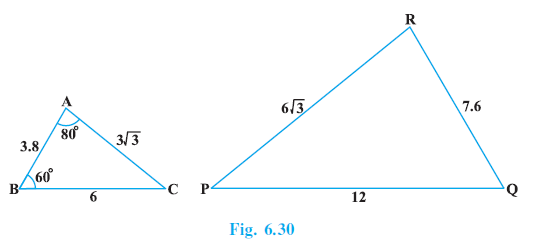
Answer:
Given:
In $\triangle ABC$: $AB = 3.8$, $BC = 6$, $AC = 3\sqrt{3}$, $\angle A = 80^\circ$, $\angle B = 60^\circ$.
In $\triangle PQR$: $PQ = 6\sqrt{3}$, $QR = 12$, $RP = 7.6$.
To Find:
The measure of $\angle P$.
Solution:
First, we check for similarity between the two triangles by comparing the ratios of their corresponding sides.
Let's find the ratios:
$\frac{AB}{RP} = \frac{3.8}{7.6} = \frac{1}{2}$
$\frac{BC}{QR} = \frac{6}{12} = \frac{1}{2}$
$\frac{AC}{PQ} = \frac{3\sqrt{3}}{6\sqrt{3}} = \frac{1}{2}$
Since the ratios of the corresponding sides are equal, i.e., $\frac{AB}{RP} = \frac{BC}{QR} = \frac{AC}{PQ} = \frac{1}{2}$, the two triangles are similar by the SSS (Side-Side-Side) similarity criterion.
The correspondence between the vertices is $A \leftrightarrow R$, $B \leftrightarrow Q$, and $C \leftrightarrow P$.
So, we write the similarity as: $\triangle ABC \sim \triangle RQP$.
Because the triangles are similar, their corresponding angles are equal.
$\angle A = \angle R = 80^\circ$
$\angle B = \angle Q = 60^\circ$
$\angle C = \angle P$
To find $\angle P$, we first need to find $\angle C$ in $\triangle ABC$. Using the angle sum property of a triangle:
$\angle A + \angle B + \angle C = 180^\circ$
$80^\circ + 60^\circ + \angle C = 180^\circ$
$140^\circ + \angle C = 180^\circ$
$\angle C = 180^\circ - 140^\circ = 40^\circ$
Since $\angle P = \angle C$, we have:
$\angle P = 40^\circ$
Thus, the measure of $\angle P$ is 40°.
Example 6. In Fig. 6.31,
OA . OB = OC . OD.
Show that ∠A = ∠C and ∠B = ∠D.
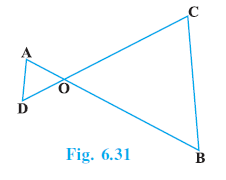
Answer:
Given:
Two line segments AC and BD intersect at point O such that:
$OA \cdot OB = OC \cdot OD$
To Prove:
$\angle A = \angle C$ and $\angle B = \angle D$.
Proof:
We are given the relation $OA \cdot OB = OC \cdot OD$. We can rearrange this to form a ratio of sides:
$\frac{OA}{OC} = \frac{OD}{OB}$
... (i)
Now, consider the triangles $\triangle AOD$ and $\triangle COB$.
From equation (i), we have two pairs of sides in proportion: $\frac{OA}{OC} = \frac{OD}{OB}$.
The angle included between sides OA and OD is $\angle AOD$.
The angle included between sides OC and OB is $\angle COB$.
These two angles are vertically opposite angles, and therefore they are equal.
$\angle AOD = \angle COB$
[Vertically opposite angles] ... (ii)
From (i) and (ii), we have two sides of $\triangle AOD$ proportional to two sides of $\triangle COB$, and the included angles are equal.
Therefore, by the SAS (Side-Angle-Side) similarity criterion:
$\triangle AOD \sim \triangle COB$
Since the triangles are similar, their corresponding angles must be equal. The correspondence is $A \leftrightarrow C$ and $D \leftrightarrow B$.
So, $\angle OAD = \angle OCB$, which means $\angle A = \angle C$.
And, $\angle ODA = \angle OBC$, which means $\angle D = \angle B$.
Hence Proved.
Example 7. A girl of height 90 cm is walking away from the base of a lamp-post at a speed of 1.2 m/s. If the lamp is 3.6 m above the ground, find the length of her shadow after 4 seconds.
Answer:
Given:
Height of the lamp-post (AB) = 3.6 m
Height of the girl (CD) = 90 cm = 0.9 m
Speed of the girl = 1.2 m/s
Time elapsed = 4 seconds
To Find:
The length of her shadow after 4 seconds.
Solution:
Let's create a diagram to represent the situation.
Let AB be the lamp-post and CD be the girl. The shadow of the girl is DE. Let the length of the shadow be $x$ meters, so $DE = x$.
First, calculate the distance the girl has walked from the base of the lamp-post in 4 seconds.
Distance (BD) = Speed $\times$ Time = $1.2 \, \text{m/s} \times 4 \, \text{s} = 4.8 \, \text{m}$.
Now, consider the two triangles, $\triangle ABE$ and $\triangle CDE$.
The lamp-post and the girl are both standing vertically on the ground, so:
$\angle B = \angle D = 90^\circ$
The angle at point E is common to both triangles:
$\angle AEB = \angle CED$
[Common angle]
By the AA (Angle-Angle) similarity criterion, the two triangles are similar:
$\triangle ABE \sim \triangle CDE$
Since the triangles are similar, the ratio of their corresponding sides is equal.
$\frac{BE}{DE} = \frac{AB}{CD}$
We know that $BE = BD + DE = 4.8 + x$.
Substituting the known values:
$\frac{4.8 + x}{x} = \frac{3.6}{0.9}$
$\frac{4.8 + x}{x} = 4$
$4.8 + x = 4x$
$4.8 = 4x - x$
$4.8 = 3x$
$x = \frac{4.8}{3} = 1.6$
Therefore, the length of her shadow after 4 seconds is 1.6 meters.
Example 8. In Fig. 6.33, CM and RN are respectively the medians of ∆ ABC and ∆ PQR. If ∆ ABC ~ ∆ PQR, prove that :
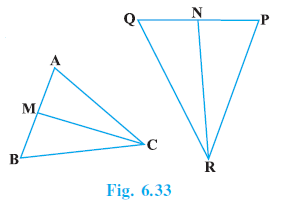
(i) ∆ AMC ~ ∆ PNR
(ii) $\frac{CN}{RN}$ = $\frac{AB}{PQ}$
(iii) ∆ CMB ~ ∆ RNQ
Answer:
Given:
$\triangle ABC \sim \triangle PQR$.
CM is the median to side AB, so M is the midpoint of AB ($AM = MB = \frac{1}{2}AB$).
RN is the median to side PQ, so N is the midpoint of PQ ($PN = NQ = \frac{1}{2}PQ$).
Properties from Given Similarity:
Since $\triangle ABC \sim \triangle PQR$, we know:
$\angle A = \angle P, \; \angle B = \angle Q, \; \angle C = \angle R$
... (1)
$\frac{AB}{PQ} = \frac{BC}{QR} = \frac{CA}{RP}$
... (2)
(i) Prove $\triangle AMC \sim \triangle PNR$
In $\triangle AMC$ and $\triangle PNR$:
From (1), we have $\angle A = \angle P$.
From (2), we have $\frac{CA}{RP} = \frac{AB}{PQ}$.
Since M and N are midpoints, $AB = 2AM$ and $PQ = 2PN$. Substituting this into the ratio:
$\frac{CA}{RP} = \frac{2AM}{2PN} \implies \frac{AC}{PR} = \frac{AM}{PN}$
We have shown that two sides are in proportion and the included angle is equal. By the SAS similarity criterion:
$\triangle AMC \sim \triangle PNR$. (Proved)
(ii) Prove $\frac{CM}{RN} = \frac{AB}{PQ}$
From the result of part (i), since $\triangle AMC \sim \triangle PNR$, the ratio of their corresponding sides is equal:
$\frac{AC}{PR} = \frac{AM}{PN} = \frac{CM}{RN}$
From (2), we know $\frac{AC}{PR} = \frac{AB}{PQ}$.
Therefore, we can equate the ratios:
$\frac{CM}{RN} = \frac{AB}{PQ}$. (Proved)
(iii) Prove $\triangle CMB \sim \triangle RNQ$
In $\triangle CMB$ and $\triangle RNQ$:
From (1), we have $\angle B = \angle Q$.
From (2), we have $\frac{BC}{QR} = \frac{AB}{PQ}$.
Since M and N are midpoints, $AB = 2MB$ and $PQ = 2NQ$. Substituting this into the ratio:
$\frac{BC}{QR} = \frac{2MB}{2NQ} \implies \frac{BC}{QR} = \frac{MB}{NQ}$
We have shown that two sides are in proportion and the included angle is equal. By the SAS similarity criterion:
$\triangle CMB \sim \triangle RNQ$. (Proved)
Exercise 6.3
Question 1. State which pairs of triangles in Fig. 6.34 are similar. Write the similarity criterion used by you for answering the question and also write the pairs of similar triangles in the symbolic form :
(i)
.png)
(ii)
.png)
(iii)
.png)
(iv)
.png)
(v)
.png)
(vi)
.png)
Answer:
(i)
Analysis:
In $\triangle ABC$ and $\triangle PQR$:
$\angle A = \angle P = 60^\circ$
$\angle B = \angle Q = 80^\circ$
$\angle C = \angle R = 40^\circ$
Since all the corresponding angles are equal, the triangles are similar.
Conclusion: Yes, the triangles are similar.
Similarity Criterion: AAA (Angle-Angle-Angle) similarity.
Symbolic Form: $\triangle ABC \sim \triangle PQR$.
(ii)
Analysis:
In $\triangle ABC$ and $\triangle QRP$:
We check the ratios of corresponding sides. Let's try to match the smallest side with the smallest, medium with medium, and largest with largest.
Smallest sides: AB = 2, QR = 4. Ratio $\frac{AB}{QR} = \frac{2}{4} = \frac{1}{2}$.
Medium sides: BC = 2.5, RP = 5. Ratio $\frac{BC}{RP} = \frac{2.5}{5} = \frac{1}{2}$.
Largest sides: AC = 3, PQ = 6. Ratio $\frac{AC}{PQ} = \frac{3}{6} = \frac{1}{2}$.
Since $\frac{AB}{QR} = \frac{BC}{RP} = \frac{AC}{PQ} = \frac{1}{2}$, the corresponding sides are proportional.
Conclusion: Yes, the triangles are similar.
Similarity Criterion: SSS (Side-Side-Side) similarity.
Symbolic Form: $\triangle ABC \sim \triangle QRP$.
(iii)
Analysis:
In $\triangle LMP$ and $\triangle DEF$:
Let's check the ratios of corresponding sides.
$\frac{MP}{DE} = \frac{2}{4} = \frac{1}{2}$
$\frac{LP}{DF} = \frac{3}{6} = \frac{1}{2}$
$\frac{LM}{EF} = \frac{2.7}{5}$
Since $\frac{1}{2} \neq \frac{2.7}{5}$, the corresponding sides are not proportional.
Conclusion: No, the triangles are not similar.
(iv)
Analysis:
In $\triangle MNL$ and $\triangle QPR$:
We are given a pair of equal angles, $\angle M = \angle Q = 70^\circ$. Let's check the ratio of the sides that include this angle.
Ratio of sides for $\triangle MNL$: MN = 2.5, ML = 5
Ratio of sides for $\triangle QPR$: QP = 5, QR = 10
Let's check the ratios: $\frac{MN}{QP} = \frac{2.5}{5} = \frac{1}{2}$ and $\frac{ML}{QR} = \frac{5}{10} = \frac{1}{2}$.
Since the ratios of the including sides are equal and the included angles are equal, the triangles are similar.
Conclusion: Yes, the triangles are similar.
Similarity Criterion: SAS (Side-Angle-Side) similarity.
Symbolic Form: $\triangle MNL \sim \triangle QPR$.
(v)
Analysis:
In $\triangle ABC$ and $\triangle FDE$:
We are given $\angle A = \angle F = 80^\circ$. Let's check the ratio of the sides that include these angles.
In $\triangle ABC$, the sides including $\angle A$ are AB (2.5) and AC (not given).
In $\triangle FDE$, the sides including $\angle F$ are FD (5) and FE (6).
The information given is about side BC, which is opposite to $\angle A$. So, we cannot apply the SAS criterion directly. Let's check the ratios of given sides: $\frac{AB}{FD} = \frac{2.5}{5} = \frac{1}{2}$ and $\frac{BC}{FE} = \frac{3}{6} = \frac{1}{2}$.
While we have two pairs of sides in proportion, the given angle ($\angle A = 80^\circ$) is included between sides AB and AC, but the corresponding angle in the other triangle ($\angle F = 80^\circ$) is included between sides FD and FE. The side corresponding to BC is FE. For SAS similarity, the angle must be *between* the two proportional sides. Here, for $\triangle ABC$, we have sides AB and BC, but the angle between them, $\angle B$, is not given. Thus, SAS does not apply.
Conclusion: No, the triangles are not similar (based on the given information).
(vi)
Analysis:
In $\triangle DEF$ and $\triangle PQR$:
First, find the third angle in each triangle using the angle sum property ($180^\circ$).
In $\triangle DEF$: $\angle F = 180^\circ - (\angle D + \angle E) = 180^\circ - (70^\circ + 80^\circ) \ $$ = 180^\circ - 150^\circ \ $$ = 30^\circ$.
In $\triangle PQR$: $\angle P = 180^\circ - (\angle Q + \angle R) = 180^\circ - (80^\circ + 30^\circ) \ $$ = 180^\circ - 110^\circ \ $$ = 70^\circ$.
Now, compare the angles of the two triangles:
$\angle D = 70^\circ$ and $\angle P = 70^\circ \implies \angle D = \angle P$.
$\angle E = 80^\circ$ and $\angle Q = 80^\circ \implies \angle E = \angle Q$.
$\angle F = 30^\circ$ and $\angle R = 30^\circ \implies \angle F = \angle R$.
Since all corresponding angles are equal, the triangles are similar.
Conclusion: Yes, the triangles are similar.
Similarity Criterion: AAA (Angle-Angle-Angle) similarity.
Symbolic Form: $\triangle DEF \sim \triangle PQR$.
Question 2. In Fig. 6.35, ∆ ODC ~ ∆ OBA, ∠BOC = 125° and ∠CDO = 70°. Find ∠DOC, ∠DCO and ∠OAB.
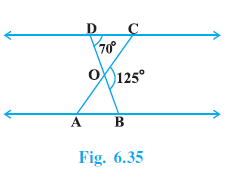
Answer:
Given:
In Fig. 6.35:
$\triangle ODC \sim \triangle OBA$
DOB is a straight line.
$\angle BOC = 125^\circ$
$\angle CDO = 70^\circ$
To Find:
$\angle DOC$
$\angle DCO$
$\angle OAB$
Solution:
1. Finding $\angle DOC$:
Since DOB is a straight line, the angles $\angle DOC$ and $\angle BOC$ form a linear pair.
The sum of angles in a linear pair is $180^\circ$.
$\angle DOC + \angle BOC = 180^\circ$
[Linear Pair Axiom]
Substitute the given value $\angle BOC = 125^\circ$:
$\angle DOC + 125^\circ = 180^\circ$
$\angle DOC = 180^\circ - 125^\circ$
$\angle DOC = 55^\circ$
2. Finding $\angle DCO$:
Consider the triangle $\triangle ODC$.
The sum of the interior angles of a triangle is $180^\circ$.
$\angle DOC + \angle CDO + \angle DCO = 180^\circ$
[Angle sum property of a triangle]
Substitute the known values $\angle DOC = 55^\circ$ and $\angle CDO = 70^\circ$:
$55^\circ + 70^\circ + \angle DCO = 180^\circ$
$125^\circ + \angle DCO = 180^\circ$
$\angle DCO = 180^\circ - 125^\circ$
$\angle DCO = 55^\circ$
3. Finding $\angle OAB$:
We are given that the triangles are similar:
$\triangle ODC \sim \triangle OBA$
In similar triangles, corresponding angles are equal.
The correspondence is $O \leftrightarrow O$, $D \leftrightarrow B$, $C \leftrightarrow A$.
Therefore, the corresponding angles are:
$\angle DOC = \angle BOA$
$\angle CDO = \angle ABO$
$\angle DCO = \angle OAB$
We need to find $\angle OAB$. From the correspondence, we have:
$\angle OAB = \angle DCO$
[Corresponding angles of similar triangles]
From step 2, we found $\angle DCO = 55^\circ$.
Therefore, $\angle OAB = 55^\circ$.
Summary of Results:
$\angle DOC = 55^\circ$
$\angle DCO = 55^\circ$
$\angle OAB = 55^\circ$
Question 3. Diagonals AC and BD of a trapezium ABCD with AB || DC intersect each other at the point O. Using a similarity criterion for two triangles, show that $\frac{OA}{OC}$ = $\frac{OB}{OD}$ .
Answer:
Given:
A trapezium ABCD in which AB || DC.
The diagonals AC and BD intersect each other at point O.
To Prove:
$\frac{OA}{OC} = \frac{OB}{OD}$
Proof:
We consider the triangles $\triangle AOB$ and $\triangle COD$.
Since AB || DC and AC is a transversal line that intersects them:
$\angle OAB = \angle OCD$
(Alternate interior angles)
Similarly, since AB || DC and BD is a transversal line that intersects them:
$\angle OBA = \angle ODC$
(Alternate interior angles)
Also, when the diagonals AC and BD intersect at O:
$\angle AOB = \angle COD$
(Vertically opposite angles)
Therefore, by AAA (Angle-Angle-Angle) similarity criterion, we have:
$\triangle AOB \sim \triangle COD$
We know that if two triangles are similar, then the ratio of their corresponding sides is equal.
Hence, for $\triangle AOB$ and $\triangle COD$:
$\frac{OA}{OC} = \frac{OB}{OD} = \frac{AB}{CD}$
From this, we can conclude that:
$\frac{OA}{OC} = \frac{OB}{OD}$
Hence Proved.
Question 4. In fig. 6.36, $\frac{QR}{QS}$ = $\frac{QT}{PR}$ and ∠1 = ∠2. Show that ∆ PQS ~ ∆ TQR.
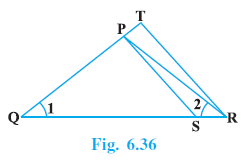
Answer:
Given:
In the given figure, we have:
$\frac{QR}{QS} = \frac{QT}{PR}$
and,
$\angle 1 = \angle 2$
To Prove:
$\triangle PQS \sim \triangle TQR$
Proof:
First, let's consider the triangle $\triangle PQR$.
It is given that $\angle 1 = \angle 2$.
From the figure, this means $\angle PQR = \angle PRQ$.
In a triangle, sides opposite to equal angles are equal. Therefore, in $\triangle PQR$,
$PQ = PR$
[Sides opposite to equal angles] ... (i)
Now, we are given the following ratio:
$\frac{QR}{QS} = \frac{QT}{PR}$
[Given]
Substituting the value of $PR$ from equation (i) into the given ratio, we get:
$\frac{QR}{QS} = \frac{QT}{PQ}$
Rearranging the terms, we get:
$\frac{PQ}{QT} = \frac{QS}{QR}$
... (ii)
Now, let's consider the triangles $\triangle PQS$ and $\triangle TQR$.
From equation (ii), we have the ratio of corresponding sides:
$\frac{PQ}{QT} = \frac{QS}{QR}$
And the included angle between these sides is:
$\angle PQS = \angle TQR = \angle 1$
(Common angle)
Thus, by the SAS (Side-Angle-Side) similarity criterion, the two triangles are similar.
$\triangle PQS \sim \triangle TQR$
Hence Proved.
Question 5. S and T are points on sides PR and QR of ∆ PQR such that ∠P = ∠RTS. Show that ∆ RPQ ~ ∆ RTS.
Answer:
Given:
In $\triangle PQR$, S is a point on side PR and T is a point on side QR.
It is given that $\angle P = \angle RTS$.
To Prove:
$\triangle RPQ \sim \triangle RTS$
Proof:
To prove that the two triangles are similar, we will use the similarity criteria for triangles.
Let's consider the triangles $\triangle RPQ$ and $\triangle RTS$.
We are given that:
$\angle RPQ = \angle RTS$
(Given)
Now, let's look at the angle at vertex R. This angle is common to both triangles.
$\angle PRQ = \angle SRT$
(Common angle)
Since two pairs of corresponding angles in $\triangle RPQ$ and $\triangle RTS$ are equal, the two triangles are similar by the AA (Angle-Angle) similarity criterion.
Therefore, $\triangle RPQ \sim \triangle RTS$.
Hence Proved.
Question 6. In Fig. 6.37, if ∆ ABE ≅ ∆ ACD, show that ∆ ADE ~ ∆ ABC.
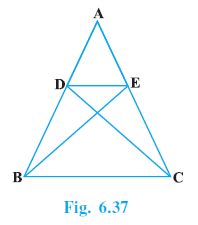
Answer:
Given:
In the figure, we are given that triangle ABE is congruent to triangle ACD:
$\triangle ABE \cong \triangle ACD$
(Given Congruence)
To Prove:
Triangle ADE is similar to triangle ABC:
$\triangle ADE \sim \triangle ABC$
Proof:
Since $\triangle ABE \cong \triangle ACD$, their corresponding parts are equal (CPCT - Corresponding Parts of Congruent Triangles).
Therefore, we have:
$AB = AC$
[CPCT] ... (i)
$AE = AD$
[CPCT]
We can rewrite the second equality as:
$AD = AE$
... (ii)
Also from CPCT, the corresponding angles are equal:
$\angle BAE = \angle CAD$
[CPCT]
Let's consider the angle $\angle DAE$. From the figure, $\angle DAE = \angle CAD$. Therefore, $\angle DAE = \angle BAE$. This represents the common angle $\angle A$ for both triangles $\triangle ADE$ and $\triangle ABC$.
$\angle DAE = \angle BAC$
[Common angle $\angle A$] ... (iii)
Now, let's examine the ratios of the sides that include this common angle in triangles $\triangle ADE$ and $\triangle ABC$. We need to check if $\frac{AD}{AB} = \frac{AE}{AC}$.
From equation (i), we have $AB = AC$.
From equation (ii), we have $AD = AE$.
Divide equation (ii) by equation (i):
$\frac{AD}{AB} = \frac{AE}{AC}$
... (iv)
(This is valid because if $x=y$ and $p=q$, then $\frac{x}{p} = \frac{y}{q}$, assuming $p, q \neq 0$).
Now, consider $\triangle ADE$ and $\triangle ABC$.
From (iii), we have $\angle DAE = \angle BAC$ (Angle).
From (iv), we have $\frac{AD}{AB} = \frac{AE}{AC}$ (Ratio of including sides).
Therefore, by the SAS (Side-Angle-Side) similarity criterion, the two triangles are similar.
$\triangle ADE \sim \triangle ABC$
Hence Proved.
Question 7. In Fig. 6.38, altitudes AD and CE of ∆ ABC intersect each other at the point P. Show that:
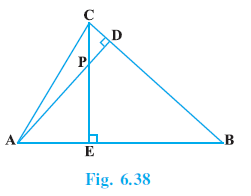
(i) ∆AEP ~ ∆CDP
(ii) ∆ABD ~ ∆CBE
(iii) ∆AEP ~ ∆ADB
(iv) ∆ PDC ~ ∆BEC
Answer:
Given:
In $\triangle ABC$:
AD is an altitude, so $AD \perp BC$. This implies $\angle ADB = 90^\circ$ and $\angle ADC = 90^\circ$.
CE is an altitude, so $CE \perp AB$. This implies $\angle CEB = 90^\circ$ and $\angle CEA = 90^\circ$.
Altitudes AD and CE intersect at point P.
To Prove:
(i) $\triangle AEP \sim \triangle CDP$
(ii) $\triangle ABD \sim \triangle CBE$
(iii) $\triangle AEP \sim \triangle ADB$
(iv) $\triangle PDC \sim \triangle BEC$
Proof:
(i) Proof of $\triangle AEP \sim \triangle CDP$
Consider $\triangle AEP$ and $\triangle CDP$.
$\angle AEP = 90^\circ$
[Since $CE \perp AB$]
$\angle CDP = 90^\circ$
[Since $AD \perp BC$]
Therefore, $\angle AEP = \angle CDP = 90^\circ$.
Also, the angles at the intersection P:
$\angle APE = \angle CPD$
[Vertically opposite angles]
Since two pairs of corresponding angles are equal, the triangles are similar by the AA similarity criterion.
$\triangle AEP \sim \triangle CDP$.
(ii) Proof of $\triangle ABD \sim \triangle CBE$
Consider $\triangle ABD$ and $\triangle CBE$.
$\angle ADB = 90^\circ$
[Since $AD \perp BC$]
$\angle CEB = 90^\circ$
[Since $CE \perp AB$]
Therefore, $\angle ADB = \angle CEB = 90^\circ$.
Now consider angle B:
$\angle ABD = \angle CBE$
[Common angle $\angle B$]
Since two pairs of corresponding angles are equal, the triangles are similar by the AA similarity criterion.
$\triangle ABD \sim \triangle CBE$.
(iii) Proof of $\triangle AEP \sim \triangle ADB$
Consider $\triangle AEP$ and $\triangle ADB$.
$\angle AEP = 90^\circ$
[Since $CE \perp AB$]
$\angle ADB = 90^\circ$
[Since $AD \perp BC$]
Therefore, $\angle AEP = \angle ADB = 90^\circ$.
Now consider angle A:
$\angle PAE = \angle DAB$
[Common angle $\angle A$]
Since two pairs of corresponding angles are equal, the triangles are similar by the AA similarity criterion.
$\triangle AEP \sim \triangle ADB$.
(iv) Proof of $\triangle PDC \sim \triangle BEC$
Consider $\triangle PDC$ and $\triangle BEC$.
$\angle PDC = 90^\circ$
[Since $AD \perp BC$]
$\angle BEC = 90^\circ$
[Since $CE \perp AB$]
Therefore, $\angle PDC = \angle BEC = 90^\circ$.
Now consider angle C:
$\angle PCD = \angle BCE$
[Common angle $\angle C$]
Since two pairs of corresponding angles are equal, the triangles are similar by the AA similarity criterion.
$\triangle PDC \sim \triangle BEC$.
Question 8. E is a point on the side AD produced of a parallelogram ABCD and BE intersects CD at F. Show that ∆ ABE ~ ∆ CFB.
Answer:
Given:
ABCD is a parallelogram.
E is a point on the side AD produced.
The line segment BE intersects the side CD at point F.
To Prove:
$\triangle ABE \sim \triangle CFB$
Proof:
In a parallelogram, opposite sides are parallel and opposite angles are equal.
First, consider the triangles $\triangle ABE$ and $\triangle CFB$.
Since ABCD is a parallelogram, we know that opposite angles are equal.
$\angle A = \angle C$
(Opposite angles of a parallelogram)
This can be written as:
$\angle EAB = \angle FCB$
... (i)
Also, in parallelogram ABCD, the opposite sides are parallel, so $AD \parallel BC$.
Since AD is produced to E, the entire line segment AE is parallel to BC.
$AE \parallel BC$
Now, let's consider BE as a transversal line intersecting the parallel lines AE and BC.
The alternate interior angles formed will be equal.
$\angle AEB = \angle CBF$
(Alternate interior angles) ... (ii)
Now, comparing $\triangle ABE$ and $\triangle CFB$, we have:
From equation (i), $\angle EAB = \angle FCB$.
From equation (ii), $\angle AEB = \angle CBF$.
Since two pairs of corresponding angles of the triangles are equal, the triangles are similar by the AA (Angle-Angle) similarity criterion.
Therefore, $\triangle ABE \sim \triangle CFB$.
Hence Proved.
Question 9. In Fig. 6.39, ABC and AMP are two right triangles, right angled at B and M respectively. Prove that:
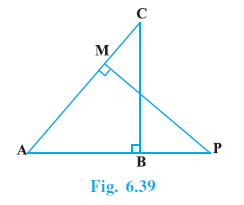
(i) ∆ABC ~ ∆AMP
(ii) $\frac{CA}{PA}$ = $\frac{BC}{MP}$
Answer:
Given:
ABC and AMP are two right triangles.
$\triangle ABC$ is right-angled at B ($\angle ABC = 90^\circ$).
$\triangle AMP$ is right-angled at M ($\angle AMP = 90^\circ$).
To Prove:
(i) $\triangle ABC \sim \triangle AMP$
(ii) $\frac{CA}{PA} = \frac{BC}{MP}$
Proof:
(i) Proof of $\triangle ABC \sim \triangle AMP$
Consider the triangles $\triangle ABC$ and $\triangle AMP$.
We are given the right angles:
$\angle ABC = 90^\circ$
[Given]
$\angle AMP = 90^\circ$
[Given]
Therefore, $\angle ABC = \angle AMP$.
Now consider the angle at vertex A.
$\angle CAB$ is an angle in $\triangle ABC$.
$\angle MAP$ is an angle in $\triangle AMP$.
These two represent the same angle.
$\angle CAB = \angle MAP$
[Common angle $\angle A$]
Since two pairs of corresponding angles in $\triangle ABC$ and $\triangle AMP$ are equal, the triangles are similar by the AA (Angle-Angle) similarity criterion.
The correspondence is $A \leftrightarrow A$, $B \leftrightarrow M$, $C \leftrightarrow P$.
Thus, $\triangle ABC \sim \triangle AMP$.
Hence Proved (i).
(ii) Proof of $\frac{CA}{PA} = \frac{BC}{MP}$
From part (i), we have proved that $\triangle ABC \sim \triangle AMP$.
Since the triangles are similar, the ratio of their corresponding sides must be equal.
Based on the correspondence $A \leftrightarrow A$, $B \leftrightarrow M$, $C \leftrightarrow P$, the corresponding sides are:
AB corresponds to AM
BC corresponds to MP
CA corresponds to PA
Therefore, the ratio of corresponding sides is:
$\frac{AB}{AM} = \frac{BC}{MP} = \frac{CA}{PA}$
[Ratio of corresponding sides of similar triangles]
From this equality, we can select the required ratio involving CA, PA, BC, and MP:
$\frac{BC}{MP} = \frac{CA}{PA}$
Rearranging to match the required format:
$\frac{CA}{PA} = \frac{BC}{MP}$
Hence Proved (ii).
Question 10. CD and GH are respectively the bisectors of ∠ACB and ∠EGF such that D and H lie on sides AB and FE of ∆ ABC and ∆ EFG respectively. If ∆ABC ~ ∆ FEG, show that:
(i) $\frac{CD}{GH}$ = $\frac{AC}{FG}$
(ii) ∆ DCB ~ ∆ HGE
(iii) ∆ DCA ~ ∆ HGF
Answer:
Given:
We have two triangles, $\triangle ABC$ and $\triangle EFG$.
It is given that $\triangle ABC \sim \triangle FEG$.
CD is the angle bisector of $\angle ACB$, with point D on side AB.
GH is the angle bisector of $\angle EGF$, with point H on side FE.
To Prove:
(i) $\frac{CD}{GH} = \frac{AC}{FG}$
(ii) $\triangle DCB \sim \triangle HGE$
(iii) $\triangle DCA \sim \triangle HGF$
Proof:
Since it is given that $\triangle ABC \sim \triangle FEG$, we know that their corresponding angles are equal and the ratio of their corresponding sides is equal.
$\angle A = \angle F$
... (a)
$\angle B = \angle E$
... (b)
$\angle ACB = \angle FGE$
... (c)
And,
$\frac{AB}{FE} = \frac{BC}{EG} = \frac{AC}{FG}$
... (d)
Since CD and GH are angle bisectors of $\angle ACB$ and $\angle FGE$ respectively:
$\angle ACD = \angle BCD = \frac{1}{2} \angle ACB$
$\angle FGH = \angle EGH = \frac{1}{2} \angle FGE$
From equation (c), we have $\angle ACB = \angle FGE$. Taking half on both sides:
$\frac{1}{2} \angle ACB = \frac{1}{2} \angle FGE$
This implies:
$\angle ACD = \angle FGH$
... (e)
And,
$\angle BCD = \angle EGH$
... (f)
(iii) Proof of $\triangle DCA \sim \triangle HGF$
Consider the triangles $\triangle DCA$ and $\triangle HGF$.
From equation (a):
$\angle DAC = \angle HFG$ (or $\angle A = \angle F$)
(Given)
From equation (e):
$\angle ACD = \angle FGH$
(Proved above)
Since two pairs of corresponding angles are equal, by the AA (Angle-Angle) similarity criterion:
$\triangle DCA \sim \triangle HGF$
Hence Proved (iii).
(i) Proof of $\frac{CD}{GH} = \frac{AC}{FG}$
We have just proved in part (iii) that $\triangle DCA \sim \triangle HGF$.
When two triangles are similar, the ratio of their corresponding sides is equal.
Therefore, for $\triangle DCA$ and $\triangle HGF$:
$\frac{DC}{HG} = \frac{CA}{GF} = \frac{DA}{HF}$
Considering the first two parts of the ratio, we get:
$\frac{CD}{GH} = \frac{AC}{FG}$
Hence Proved (i).
(ii) Proof of $\triangle DCB \sim \triangle HGE$
Consider the triangles $\triangle DCB$ and $\triangle HGE$.
From equation (b):
$\angle DBC = \angle HEG$ (or $\angle B = \angle E$)
(Given)
From equation (f):
$\angle BCD = \angle EGH$
(Proved above)
Since two pairs of corresponding angles are equal, by the AA (Angle-Angle) similarity criterion:
$\triangle DCB \sim \triangle HGE$
Hence Proved (ii).
Question 11. In Fig. 6.40, E is a point on side CB produced of an isosceles triangle ABC with AB = AC. If AD⊥BC and EF⊥AC, prove that ∆ ABD ~ ∆ ECF.
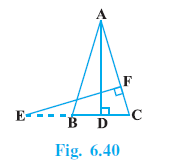
Answer:
Given:
$\triangle ABC$ is an isosceles triangle with $AB = AC$.
E is a point on side CB produced.
$AD \perp BC$, which implies $\angle ADB = 90^\circ$.
$EF \perp AC$, which implies $\angle EFC = 90^\circ$.
To Prove:
$\triangle ABD \sim \triangle ECF$
Proof:
Since $\triangle ABC$ is an isosceles triangle with $AB = AC$, the angles opposite to these equal sides must be equal.
$\angle ABC = \angle ACB$
[Angles opposite to equal sides of a triangle are equal]
We can write $\angle ABC$ as $\angle ABD$ (as D lies on BC) and $\angle ACB$ as $\angle ECF$ (as E lies on CB produced).
$\angle ABD = \angle ECF$
... (i)
Now, consider the triangles $\triangle ABD$ and $\triangle ECF$.
From the given information about altitudes:
$\angle ADB = 90^\circ$
[Given $AD \perp BC$]
$\angle EFC = 90^\circ$
[Given $EF \perp AC$]
Therefore,
$\angle ADB = \angle EFC = 90^\circ$
... (ii)
From equation (i) and equation (ii), we have two pairs of corresponding angles equal in $\triangle ABD$ and $\triangle ECF$:
$\angle ABD = \angle ECF$
$\angle ADB = \angle EFC$
Therefore, by the AA (Angle-Angle) similarity criterion, the two triangles are similar.
$\triangle ABD \sim \triangle ECF$
Hence Proved.
Question 12. Sides AB and BC and median AD of a triangle ABC are respectively proportional to sides PQ and QR and median PM of ∆ PQR (see Fig. 6.41). Show that ∆ ABC ~ ∆ PQR.
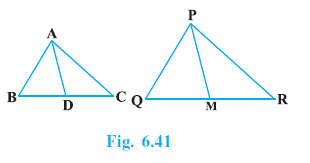
Answer:
Given:
Two triangles $\triangle ABC$ and $\triangle PQR$.
AD is the median to side BC in $\triangle ABC$, so D is the midpoint of BC ($BD = DC = \frac{1}{2}BC$).
PM is the median to side QR in $\triangle PQR$, so M is the midpoint of QR ($QM = MR = \frac{1}{2}QR$).
The sides AB, BC and median AD of $\triangle ABC$ are respectively proportional to sides PQ, QR and median PM of $\triangle PQR$.
$\frac{AB}{PQ} = \frac{BC}{QR} = \frac{AD}{PM}$
... (i)
To Prove:
$\triangle ABC \sim \triangle PQR$.
Proof:
From the given proportionality (i), we have:
$\frac{AB}{PQ} = \frac{BC}{QR} = \frac{AD}{PM}$
Since D is the midpoint of BC, $BC = 2BD$.
Since M is the midpoint of QR, $QR = 2QM$.
Substitute these into the second ratio of the given proportionality:
$\frac{BC}{QR} = \frac{2BD}{2QM} = \frac{BD}{QM}$
Now, substitute this back into the proportionality (i):
$\frac{AB}{PQ} = \frac{BD}{QM} = \frac{AD}{PM}$
... (ii)
Consider the triangles $\triangle ABD$ and $\triangle PQM$.
From equation (ii), we have:
$\frac{AB}{PQ} = \frac{BD}{QM} = \frac{AD}{PM}$
This shows that all three pairs of corresponding sides of $\triangle ABD$ and $\triangle PQM$ are proportional.
Therefore, by the SSS (Side-Side-Side) similarity criterion:
$\triangle ABD \sim \triangle PQM$.
Since the triangles $\triangle ABD$ and $\triangle PQM$ are similar, their corresponding angles must be equal.
$\angle ABD = \angle PQM$
[Corresponding angles of similar triangles]
This means $\angle B = \angle Q$.
$\angle B = \angle Q$
... (iii)
Now consider the original triangles $\triangle ABC$ and $\triangle PQR$.
From the given proportionality (i), we have:
$\frac{AB}{PQ} = \frac{BC}{QR}$
[Ratio of two sides]
From (iii), we have the included angles equal:
$\angle B = \angle Q$
[Included angle]
Therefore, by the SAS (Side-Angle-Side) similarity criterion:
$\triangle ABC \sim \triangle PQR$.
Hence Proved.
Question 13. D is a point on the side BC of a triangle ABC such that ∠ADC = ∠BAC. Show that CA2 = CB.CD.
Answer:
Given:
A triangle $\triangle ABC$ where D is a point on the side BC.
$\angle ADC = \angle BAC$
(Given condition)
To Prove:
$CA^2 = CB \cdot CD$
Proof:
To prove the required relation, we will show that the triangles involving these sides are similar.
Let's consider $\triangle ABC$ and $\triangle DAC$.
In $\triangle ABC$ and $\triangle DAC$:
$\angle BAC = \angle ADC$
[Given]
$\angle BCA = \angle DCA$
[Common angle $\angle C$]
Since two angles of $\triangle ABC$ are equal to two corresponding angles of $\triangle DAC$, the two triangles are similar by the AA (Angle-Angle) similarity criterion.
Therefore, $\triangle ABC \sim \triangle DAC$.
When two triangles are similar, the ratio of their corresponding sides is equal. The corresponding sides are opposite to the equal angles.
- Side opposite to $\angle ABC$ is AC, and side opposite to the corresponding angle $\angle DAC$ is DC.
- Side opposite to $\angle BAC$ is BC, and side opposite to the corresponding angle $\angle ADC$ is AC.
- Side opposite to $\angle BCA$ is AB, and side opposite to the corresponding angle $\angle DCA$ is DA.
So, the ratio of corresponding sides is:
$\frac{BC}{AC} = \frac{AC}{DC} = \frac{AB}{DA}$
[Corresponding sides of similar triangles]
Taking the first two parts of the ratio:
$\frac{BC}{AC} = \frac{AC}{DC}$
Using the notation from the question (CA for AC, CB for BC):
$\frac{CB}{CA} = \frac{CA}{CD}$
Now, cross-multiplying the terms, we get:
$CA \cdot CA = CB \cdot CD$
$CA^2 = CB \cdot CD$
Hence Proved.
Question 14. Sides AB and AC and median AD of a triangle ABC are respectively proportional to sides PQ and PR and median PM of another triangle PQR. Show that ∆ABC ~ ∆ PQR.
Answer:
Given:
Two triangles, $\triangle ABC$ and $\triangle PQR$.
AD is the median to side BC in $\triangle ABC$, so D is the midpoint of BC.
PM is the median to side QR in $\triangle PQR$, so M is the midpoint of QR.
The sides and medians are proportional as follows:
$\frac{AB}{PQ} = \frac{AC}{PR} = \frac{AD}{PM}$
... (i)
To Prove:
$\triangle ABC \sim \triangle PQR$.
Construction Required:
Produce AD to a point E such that $AD = DE$. Join CE.
Similarly, produce PM to a point N such that $PM = MN$. Join RN.
Proof:
In $\triangle ABD$ and $\triangle ECD$:
AD = ED
(By Construction)
BD = CD
(AD is the median)
$\angle ADB = \angle EDC$
(Vertically opposite angles)
By SAS congruence criterion, $\triangle ABD \cong \triangle ECD$.
Therefore, by CPCT (Corresponding Parts of Congruent Triangles):
$AB = EC$
... (ii)
and $\angle BAD = \angle CED$
... (iii)
Similarly, in $\triangle PQM$ and $\triangle NRM$:
PM = NM
(By Construction)
QM = RM
(PM is the median)
$\angle PMQ = \angle NMR$
(Vertically opposite angles)
By SAS congruence criterion, $\triangle PQM \cong \triangle NRM$.
Therefore, by CPCT:
$PQ = NR$
... (iv)
and $\angle QPM = \angle MNR$
... (v)
From the given relation (i):
$\frac{AB}{PQ} = \frac{AC}{PR} = \frac{AD}{PM}$
Substitute $AB = EC$ from (ii) and $PQ = NR$ from (iv). Also, $AE = 2AD$ and $PN = 2PM$.
$\frac{EC}{NR} = \frac{AC}{PR} = \frac{\frac{1}{2}AE}{\frac{1}{2}PN}$
$\implies \frac{AC}{PR} = \frac{EC}{NR} = \frac{AE}{PN}$
This shows that the sides of $\triangle ACE$ are proportional to the sides of $\triangle PRN$.
Therefore, by SSS similarity criterion, $\triangle ACE \sim \triangle PRN$.
Since the triangles are similar, their corresponding angles are equal.
$\angle CAE = \angle RPN$
... (vi)
and $\angle CED = \angle MNR$
... (vii)
From (iii), we have $\angle BAD = \angle CED$. From (v), we have $\angle QPM = \angle MNR$. And from (vii), we have $\angle CED = \angle MNR$.
Combining these, we get:
$\angle BAD = \angle QPM$
... (viii)
Now, we add equations (vi) and (viii):
$\angle CAE + \angle BAD = \angle RPN + \angle QPM$
From the figure, $\angle CAE + \angle BAD$ is $\angle BAC$, and $\angle RPN + \angle QPM$ is $\angle QPR$.
So, $\angle BAC = \angle QPR$.
Now, let's consider the original triangles, $\triangle ABC$ and $\triangle PQR$.
From the given information (i), we have $\frac{AB}{PQ} = \frac{AC}{PR}$.
And we have just proved that the included angle $\angle BAC = \angle QPR$.
Therefore, by the SAS (Side-Angle-Side) similarity criterion:
$\triangle ABC \sim \triangle PQR$.
Hence Proved.
Question 15. A vertical pole of length 6 m casts a shadow 4 m long on the ground and at the same time a tower casts a shadow 28 m long. Find the height of the tower.
Answer:
Given:
Height of the vertical pole = 6 m.
Length of the shadow cast by the pole = 4 m.
Length of the shadow cast by a tower at the same time = 28 m.
To Find:
The height of the tower.
Solution:
Let AB be the vertical pole and BC be its shadow. Let PQ be the tower and QR be its shadow.
We are given:
Height of pole, $AB = 6$ m.
Length of pole's shadow, $BC = 4$ m.
Length of tower's shadow, $QR = 28$ m.
Let the height of the tower be $PQ = h$ meters.
Since both the pole and the tower are vertical to the ground, they form right angles with the ground.
So, $\angle ABC = 90^\circ$ and $\angle PQR = 90^\circ$.
As the shadows are cast at the same time, the angle of elevation of the sun will be the same for both the pole and the tower. The angle of elevation is the angle made by the shadow with the line connecting the top of the object to the tip of the shadow.
Let the angle of elevation be $\theta$. Then, $\angle ACB = \angle PRQ = \theta$.
Now, consider $\triangle ABC$ and $\triangle PQR$:
$\angle ABC = \angle PQR$
[Both are $90^\circ$]
$\angle ACB = \angle PRQ$
[Same angle of elevation]
By the AA (Angle-Angle) similarity criterion, the two triangles are similar.
$\triangle ABC \sim \triangle PQR$
Since the triangles are similar, the ratio of their corresponding sides must be equal.
$\frac{\text{Height of Pole}}{\text{Height of Tower}} = \frac{\text{Length of Pole's Shadow}}{\text{Length of Tower's Shadow}}$
$\frac{AB}{PQ} = \frac{BC}{QR}$
Substitute the given values into the equation:
$\frac{6}{h} = \frac{4}{28}$
To solve for h, we can cross-multiply:
$4 \times h = 6 \times 28$
$h = \frac{6 \times 28}{4}$
Simplifying the fraction:
$h = 6 \times \frac{\cancel{28}^7}{\cancel{4}_1}$
$h = 6 \times 7$
$h = 42$
Therefore, the height of the tower is 42 meters.
Question 16. If AD and PM are medians of triangles ABC and PQR, respectively where ∆ ABC ~ ∆ PQR, prove that $\frac{AB}{PQ}$ = $\frac{AD}{PM}$ .
Answer:
Given:
Two triangles, $\triangle ABC$ and $\triangle PQR$, are similar.
$\triangle ABC \sim \triangle PQR$.
AD is the median of $\triangle ABC$ on the side BC, so $BD = DC = \frac{1}{2}BC$.
PM is the median of $\triangle PQR$ on the side QR, so $QM = MR = \frac{1}{2}QR$.
To Prove:
$\frac{AB}{PQ} = \frac{AD}{PM}$.
Proof:
Since it is given that $\triangle ABC \sim \triangle PQR$, we know two main properties:
1. The ratio of their corresponding sides is equal.
$\frac{AB}{PQ} = \frac{BC}{QR} = \frac{AC}{PR}$
... (i)
2. Their corresponding angles are equal.
$\angle B = \angle Q$
... (ii)
From the ratio of sides in (i), we have:
$\frac{AB}{PQ} = \frac{BC}{QR}$
Since AD and PM are medians, we know $BC = 2BD$ and $QR = 2QM$. Substituting these into the equation:
$\frac{AB}{PQ} = \frac{2BD}{2QM}$
$\frac{AB}{PQ} = \frac{BD}{QM}$
... (iii)
Now, let's consider the triangles $\triangle ABD$ and $\triangle PQM$.
From (ii), we have the included angles:
$\angle B = \angle Q$ (or $\angle ABD = \angle PQM$)
[From similarity of $\triangle ABC$ and $\triangle PQR$]
From (iii), we have the ratio of the sides that form these angles:
$\frac{AB}{PQ} = \frac{BD}{QM}$
Based on these two conditions, by the SAS (Side-Angle-Side) similarity criterion, we can conclude that:
$\triangle ABD \sim \triangle PQM$.
Since these two triangles are similar, the ratio of their corresponding sides is equal.
$\frac{AB}{PQ} = \frac{BD}{QM} = \frac{AD}{PM}$
[Corresponding sides of similar triangles]
From this relationship, we can directly state the required proof:
$\frac{AB}{PQ} = \frac{AD}{PM}$
Hence Proved.
(This also proves a general property: The ratio of corresponding medians of two similar triangles is the same as the ratio of their corresponding sides.)
Example 9 (Before Exercise 6.4)
Example 9. In Fig. 6.43, the line segment XY is parallel to side AC of ∆ ABC and it divides the triangle into two parts of equal areas. Find the ratio $\frac{AX}{AB}$ .
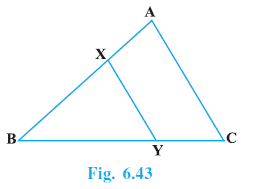
Answer:
Given:
In $\triangle ABC$, the line segment XY is parallel to side AC ($XY \parallel AC$).
X is a point on AB and Y is a point on BC.
The line segment XY divides $\triangle ABC$ into two parts of equal areas.
This means, area($\triangle XBY$) = area(trapezium AXYC).
To Find:
The ratio $\frac{AX}{AB}$.
Solution:
We are given that $XY \parallel AC$.
Consider $\triangle XBY$ and $\triangle ABC$.
$\angle BXY = \angle BAC$
[Corresponding angles, as $XY \parallel AC$ and AB is transversal]
$\angle BYX = \angle BCA$
[Corresponding angles, as $XY \parallel AC$ and BC is transversal]
$\angle XBY = \angle ABC$
[Common angle B]
Therefore, by AAA similarity criterion (or AA similarity), the triangles are similar:
$\triangle XBY \sim \triangle ABC$.
We know that the ratio of the areas of two similar triangles is equal to the square of the ratio of their corresponding sides.
$\frac{\text{area}(\triangle XBY)}{\text{area}(\triangle ABC)} = \left(\frac{XB}{AB}\right)^2 = \left(\frac{BY}{BC}\right)^2 = \left(\frac{XY}{AC}\right)^2$
... (i)
We are given that XY divides the triangle into two parts of equal areas:
area($\triangle XBY$) = area(trapezium AXYC)
The total area of $\triangle ABC$ is the sum of these two areas:
area($\triangle ABC$) = area($\triangle XBY$) + area(trapezium AXYC)
area($\triangle ABC$) = area($\triangle XBY$) + area($\triangle XBY$)
area($\triangle ABC$) = 2 $\times$ area($\triangle XBY$)
Therefore, the ratio of the areas is:
$\frac{\text{area}(\triangle XBY)}{\text{area}(\triangle ABC)} = \frac{1}{2}$
... (ii)
Equating the results from (i) and (ii):
$\left(\frac{XB}{AB}\right)^2 = \frac{1}{2}$
Taking the square root on both sides (lengths are positive):
$\frac{XB}{AB} = \frac{1}{\sqrt{2}}$
Rationalizing the denominator:
$\frac{XB}{AB} = \frac{1 \times \sqrt{2}}{\sqrt{2} \times \sqrt{2}} = \frac{\sqrt{2}}{2}$
... (iii)
We need to find the ratio $\frac{AX}{AB}$.
From the figure, we can see that $AX = AB - XB$.
Divide by AB:
$\frac{AX}{AB} = \frac{AB - XB}{AB}$
$\frac{AX}{AB} = \frac{AB}{AB} - \frac{XB}{AB}$
$\frac{AX}{AB} = 1 - \frac{XB}{AB}$
Substitute the value of $\frac{XB}{AB}$ from (iii):
$\frac{AX}{AB} = 1 - \frac{\sqrt{2}}{2}$
$\frac{AX}{AB} = \frac{2 - \sqrt{2}}{2}$
Therefore, the required ratio is $\frac{AX}{AB} = \frac{2 - \sqrt{2}}{2}$.
Exercise 6.4
Question 1. Let ∆ ABC ~ ∆ DEF and their areas be, respectively, 64 cm2 and 121 cm2 . If EF = 15.4 cm, find BC.
Answer:
Given:
Two similar triangles, $\triangle ABC \sim \triangle DEF$.
Area($\triangle ABC$) = 64 cm2.
Area($\triangle DEF$) = 121 cm2.
$EF = 15.4$ cm.
To Find:
The length of the side BC.
Solution:
According to the theorem on the areas of similar triangles, if two triangles are similar, the ratio of their areas is equal to the square of the ratio of their corresponding sides.
Since $\triangle ABC \sim \triangle DEF$, their corresponding sides are AB and DE, BC and EF, and AC and DF.
Therefore, we can write the relation as:
$\frac{\text{Area}(\triangle ABC)}{\text{Area}(\triangle DEF)} = \left(\frac{AB}{DE}\right)^2 = \left(\frac{BC}{EF}\right)^2 = \left(\frac{AC}{DF}\right)^2$
To find the length of BC, we use the part of the relation that involves BC and its corresponding side EF:
$\frac{\text{Area}(\triangle ABC)}{\text{Area}(\triangle DEF)} = \left(\frac{BC}{EF}\right)^2$
Substituting the given values into the equation:
$\frac{64}{121} = \left(\frac{BC}{15.4}\right)^2$
To solve for BC, we first take the square root of both sides of the equation. Since side lengths must be positive, we only consider the positive root.
$\sqrt{\frac{64}{121}} = \frac{BC}{15.4}$
$\frac{8}{11} = \frac{BC}{15.4}$
Now, we can solve for BC by multiplying both sides by 15.4:
$BC = \frac{8}{11} \times 15.4$
$BC = \frac{8 \times 15.4}{11}$
Since $11 \times 1.4 = 15.4$, we can simplify the expression:
$BC = \frac{8 \times \cancel{15.4}^{1.4}}{\cancel{11}_1}$
$BC = 8 \times 1.4$
$BC = 11.2$
Therefore, the length of side BC is 11.2 cm.
Question 2. Diagonals of a trapezium ABCD with AB || DC intersect each other at the point O. If AB = 2 CD, find the ratio of the areas of triangles AOB and COD.
Answer:
Given:
A trapezium ABCD in which the side $AB$ is parallel to the side $DC$ ($AB \parallel DC$).
The diagonals AC and BD intersect each other at the point O.
$AB = 2 \cdot CD$
To Find:
The ratio of the area of $\triangle AOB$ to the area of $\triangle COD$.
Solution:
First, we need to establish a relationship between $\triangle AOB$ and $\triangle COD$. Let's prove that they are similar.
In $\triangle AOB$ and $\triangle COD$:
Since $AB \parallel DC$ and BD is a transversal line cutting across them:
$\angle OBA = \angle ODC$
[Alternate interior angles]
Similarly, since $AB \parallel DC$ and AC is a transversal:
$\angle OAB = \angle OCD$
[Alternate interior angles]
Also, the angles at the intersection point O are vertically opposite:
$\angle AOB = \angle COD$
[Vertically opposite angles]
Since two pairs of corresponding angles are equal, by the AA similarity criterion, the triangles are similar.
$\triangle AOB \sim \triangle COD$.
Now, we can use the theorem that states the ratio of the areas of two similar triangles is equal to the square of the ratio of their corresponding sides.
$\frac{\text{Area}(\triangle AOB)}{\text{Area}(\triangle COD)} = \left(\frac{AB}{CD}\right)^2 = \left(\frac{AO}{CO}\right)^2 = \left(\frac{BO}{DO}\right)^2$
We are given the relationship between the sides AB and CD. So we use that part of the ratio:
$\frac{\text{Area}(\triangle AOB)}{\text{Area}(\triangle COD)} = \left(\frac{AB}{CD}\right)^2$
Substitute the given relation $AB = 2 \cdot CD$ into the equation:
$\frac{\text{Area}(\triangle AOB)}{\text{Area}(\triangle COD)} = \left(\frac{2 \cdot CD}{CD}\right)^2$
Cancel out the common term CD:
$\frac{\text{Area}(\triangle AOB)}{\text{Area}(\triangle COD)} = \left(\frac{2 \cancel{CD}}{\cancel{CD}}\right)^2 = (2)^2 = 4$
The ratio can be expressed as $\frac{4}{1}$.
Therefore, the ratio of the areas of $\triangle AOB$ and $\triangle COD$ is 4 : 1.
Question 3. In Fig. 6.44, ABC and DBC are two triangles on the same base BC. If AD intersects BC at O, show that
$\frac{ar (ABC)}{ar (DBC)}$ = $\frac{AO}{DO}$.
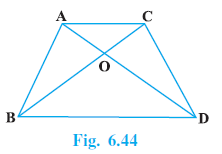
Answer:
Given:
$\triangle ABC$ and $\triangle DBC$ are two triangles sharing the same base BC.
The line segment AD intersects the base BC at the point O.
To Prove:
$\frac{\text{ar}(\triangle ABC)}{\text{ar}(\triangle DBC)} = \frac{AO}{DO}$
Construction Required:
To relate the areas, we need the heights of the triangles. Let's draw altitudes from vertices A and D to the base BC.
1. Draw $AM \perp BC$.
2. Draw $DN \perp BC$.
Proof:
The area of a triangle is given by the formula $\frac{1}{2} \times \text{base} \times \text{height}$.
For $\triangle ABC$, the base is BC and the height (altitude) is AM.
ar($\triangle ABC$) = $\frac{1}{2} \times BC \times AM$
... (i)
For $\triangle DBC$, the base is BC and the height (altitude) is DN.
ar($\triangle DBC$) = $\frac{1}{2} \times BC \times DN$
... (ii)
To find the ratio of their areas, we divide equation (i) by equation (ii):
$\frac{\text{ar}(\triangle ABC)}{\text{ar}(\triangle DBC)} = \frac{\frac{1}{2} \times BC \times AM}{\frac{1}{2} \times BC \times DN}$
The common terms $\frac{1}{2}$ and $BC$ cancel out, leaving:
$\frac{\text{ar}(\triangle ABC)}{\text{ar}(\triangle DBC)} = \frac{AM}{DN}$
... (iii)
Now, we need to find a relationship between $\frac{AM}{DN}$ and $\frac{AO}{DO}$. Consider the two right-angled triangles $\triangle AMO$ and $\triangle DNO$.
In $\triangle AMO$ and $\triangle DNO$:
$\angle AMO = \angle DNO$
[Both are $90^\circ$ by construction]
$\angle AOM = \angle DON$
[Vertically opposite angles]
Since two pairs of corresponding angles are equal, by the AA similarity criterion, the triangles are similar.
$\triangle AMO \sim \triangle DNO$.
For similar triangles, the ratio of corresponding sides is equal.
$\frac{AM}{DN} = \frac{MO}{NO} = \frac{AO}{DO}$
From this, we get the specific ratio we need:
$\frac{AM}{DN} = \frac{AO}{DO}$
... (iv)
Finally, we can substitute the result from equation (iv) back into equation (iii):
$\frac{\text{ar}(\triangle ABC)}{\text{ar}(\triangle DBC)} = \frac{AO}{DO}$
Hence Proved.
Question 4. If the areas of two similar triangles are equal, prove that they are congruent.
Answer:
Given:
Two triangles, $\triangle ABC$ and $\triangle PQR$.
The triangles are similar: $\triangle ABC \sim \triangle PQR$.
Their areas are equal: Area($\triangle ABC$) = Area($\triangle PQR$).
To Prove:
The triangles are congruent: $\triangle ABC \cong \triangle PQR$.
Proof:
We are given that $\triangle ABC \sim \triangle PQR$.
By the theorem on areas of similar triangles, the ratio of their areas is equal to the square of the ratio of their corresponding sides.
$\frac{\text{Area}(\triangle ABC)}{\text{Area}(\triangle PQR)} = \left(\frac{AB}{PQ}\right)^2 = \left(\frac{BC}{QR}\right)^2 = \left(\frac{AC}{PR}\right)^2$
... (i)
It is also given that their areas are equal:
Area($\triangle ABC$) = Area($\triangle PQR$).
This implies that the ratio of their areas is 1.
$\frac{\text{Area}(\triangle ABC)}{\text{Area}(\triangle PQR)} = 1$
... (ii)
Combining equations (i) and (ii), we have:
$1 = \left(\frac{AB}{PQ}\right)^2 = \left(\frac{BC}{QR}\right)^2 = \left(\frac{AC}{PR}\right)^2$
Let's consider each ratio separately:
1. $\left(\frac{AB}{PQ}\right)^2 = 1 \implies \frac{AB}{PQ} = 1 \implies AB = PQ$.
2. $\left(\frac{BC}{QR}\right)^2 = 1 \implies \frac{BC}{QR} = 1 \implies BC = QR$.
3. $\left(\frac{AC}{PR}\right)^2 = 1 \implies \frac{AC}{PR} = 1 \implies AC = PR$.
Now, in $\triangle ABC$ and $\triangle PQR$, we have shown that all three pairs of corresponding sides are equal in length:
AB = PQ
(Side)
BC = QR
(Side)
AC = PR
(Side)
By the SSS (Side-Side-Side) congruence criterion, if three sides of one triangle are equal to the three corresponding sides of another triangle, the triangles are congruent.
Therefore, $\triangle ABC \cong \triangle PQR$.
Hence Proved.
Question 5. D, E and F are respectively the mid-points of sides AB, BC and CA of ∆ ABC. Find the ratio of the areas of ∆ DEF and ∆ ABC.
Answer:
Given:
In $\triangle ABC$, D, E, and F are the mid-points of sides AB, BC, and CA, respectively.
To Find:
The ratio of the areas: $\frac{\text{Area}(\triangle DEF)}{\text{Area}(\triangle ABC)}$.
Solution:
We will use the Mid-point Theorem, which states that the line segment connecting the mid-points of two sides of a triangle is parallel to the third side and is half the length of the third side.
Applying the theorem to the sides of $\triangle DEF$:
- For sides AB and BC, D and E are mid-points. So, $DE \parallel AC$ and $DE = \frac{1}{2}AC$.
- For sides BC and CA, E and F are mid-points. So, $EF \parallel AB$ and $EF = \frac{1}{2}AB$.
- For sides CA and AB, F and D are mid-points. So, $FD \parallel BC$ and $FD = \frac{1}{2}BC$.
Now, let's compare $\triangle DEF$ with the original triangle $\triangle ABC$. Let's check for similarity by comparing the ratios of corresponding sides. We will compare $\triangle DEF$ with $\triangle CAB$.
$\frac{DE}{CA} = \frac{\frac{1}{2}AC}{AC} = \frac{1}{2}$
$\frac{EF}{AB} = \frac{\frac{1}{2}AB}{AB} = \frac{1}{2}$
$\frac{FD}{BC} = \frac{\frac{1}{2}BC}{BC} = \frac{1}{2}$
Since the ratios of all three pairs of corresponding sides are equal,
$\frac{DE}{CA} = \frac{EF}{AB} = \frac{FD}{BC} = \frac{1}{2}$
By the SSS (Side-Side-Side) similarity criterion, the triangles are similar:
$\triangle DEF \sim \triangle CAB$ (which is $\triangle ABC$).
Now, we use the theorem that the ratio of the areas of two similar triangles is the square of the ratio of their corresponding sides.
$\frac{\text{Area}(\triangle DEF)}{\text{Area}(\triangle CAB)} = \left(\frac{DE}{CA}\right)^2$
Substitute the value of the ratio of the sides:
$\frac{\text{Area}(\triangle DEF)}{\text{Area}(\triangle ABC)} = \left(\frac{1}{2}\right)^2 = \frac{1}{4}$
Therefore, the ratio of the areas of $\triangle DEF$ and $\triangle ABC$ is 1 : 4.
Question 6. Prove that the ratio of the areas of two similar triangles is equal to the square of the ratio of their corresponding medians.
Answer:
Given:
Two similar triangles, $\triangle ABC \sim \triangle PQR$.
AD is the median to side BC in $\triangle ABC$.
PM is the median to side QR in $\triangle PQR$.
To Prove:
$\frac{\text{Area}(\triangle ABC)}{\text{Area}(\triangle PQR)} = \left(\frac{AD}{PM}\right)^2$.
Proof:
Since $\triangle ABC \sim \triangle PQR$, the ratio of their areas is equal to the square of the ratio of their corresponding sides.
$\frac{\text{Area}(\triangle ABC)}{\text{Area}(\triangle PQR)} = \left(\frac{AB}{PQ}\right)^2$
... (i)
Also, from the similarity of $\triangle ABC$ and $\triangle PQR$, we know that the ratio of corresponding sides is equal and corresponding angles are equal.
$\frac{AB}{PQ} = \frac{BC}{QR}$
... (ii)
$\angle B = \angle Q$
... (iii)
Since AD and PM are medians, D is the midpoint of BC and M is the midpoint of QR. Therefore:
$BC = 2BD$ and $QR = 2QM$.
Substitute these into equation (ii):
$\frac{AB}{PQ} = \frac{2BD}{2QM} \implies \frac{AB}{PQ} = \frac{BD}{QM}$
Now, consider $\triangle ABD$ and $\triangle PQM$.
We have $\frac{AB}{PQ} = \frac{BD}{QM}$ and the included angle $\angle B = \angle Q$ from (iii).
Therefore, by the SAS similarity criterion:
$\triangle ABD \sim \triangle PQM$.
Since these smaller triangles are similar, the ratio of their corresponding sides is equal:
$\frac{AB}{PQ} = \frac{BD}{QM} = \frac{AD}{PM}$
From this, we can take the relation we need:
$\frac{AB}{PQ} = \frac{AD}{PM}$
... (iv)
Finally, substitute the result from (iv) into our starting equation (i):
$\frac{\text{Area}(\triangle ABC)}{\text{Area}(\triangle PQR)} = \left(\frac{AD}{PM}\right)^2$
Hence Proved.
Question 7. Prove that the area of an equilateral triangle described on one side of a square is equal to half the area of the equilateral triangle described on one of its diagonals.
Answer:
Given:
A square, let's call it ABCD.
An equilateral triangle (say $\triangle BCE$) is described on one of its sides (BC).
Another equilateral triangle (say $\triangle ACF$) is described on one of its diagonals (AC).
To Prove:
Area($\triangle BCE$) = $\frac{1}{2} \times$ Area($\triangle ACF$).
Proof:
Let the length of the side of the square ABCD be $a$.
So, $AB = BC = CD = DA = a$.
The equilateral triangle $\triangle BCE$ is on the side BC, so the length of each side of $\triangle BCE$ is $a$.
Next, we find the length of the diagonal AC. In the right-angled triangle $\triangle ABC$, by the Pythagorean theorem:
$AC^2 = AB^2 + BC^2$
$AC^2 = a^2 + a^2 = 2a^2$
$AC = \sqrt{2a^2} = a\sqrt{2}$.
The equilateral triangle $\triangle ACF$ is on the diagonal AC, so the length of each side of $\triangle ACF$ is $a\sqrt{2}$.
All equilateral triangles are similar to each other since all their interior angles are $60^\circ$.
Therefore, $\triangle BCE \sim \triangle ACF$.
Using the theorem on the areas of similar triangles, the ratio of their areas is equal to the square of the ratio of their corresponding sides.
$\frac{\text{Area}(\triangle BCE)}{\text{Area}(\triangle ACF)} = \left(\frac{\text{Side of } \triangle BCE}{\text{Side of } \triangle ACF}\right)^2$
Substitute the lengths of the sides BC and AC:
$\frac{\text{Area}(\triangle BCE)}{\text{Area}(\triangle ACF)} = \left(\frac{BC}{AC}\right)^2 = \left(\frac{a}{a\sqrt{2}}\right)^2$
Simplify the expression inside the parentheses:
$\frac{\text{Area}(\triangle BCE)}{\text{Area}(\triangle ACF)} = \left(\frac{1}{\sqrt{2}}\right)^2$
$\frac{\text{Area}(\triangle BCE)}{\text{Area}(\triangle ACF)} = \frac{1^2}{(\sqrt{2})^2} = \frac{1}{2}$
By cross-multiplication, we get the required result:
Area($\triangle BCE$) = $\frac{1}{2}$ Area($\triangle ACF$).
Hence Proved.
Tick the correct answer and justify :
Question 8. ABC and BDE are two equilateral triangles such that D is the mid-point of BC. Ratio of the areas of triangles ABC and BDE is
(A) 2 : 1
(B) 1 : 2
(C) 4 : 1
(D) 1 : 4
Answer:
Given:
$\triangle ABC$ and $\triangle BDE$ are equilateral triangles.
D is the mid-point of the side BC.
To Find:
The ratio of Area($\triangle ABC$) to Area($\triangle BDE$).
Justification:
Since both $\triangle ABC$ and $\triangle BDE$ are equilateral, all their angles are $60^\circ$. Therefore, the two triangles are similar by AAA similarity criterion.
$\triangle ABC \sim \triangle BDE$.
Let the side length of the larger triangle $\triangle ABC$ be $s$. So, $AB = BC = AC = s$.
Since D is the mid-point of BC, the length of BD is half the length of BC.
$BD = \frac{1}{2} BC = \frac{s}{2}$.
The triangle $\triangle BDE$ is equilateral, so all its sides are equal to BD. The side length of $\triangle BDE$ is $\frac{s}{2}$.
The ratio of the areas of two similar triangles is equal to the square of the ratio of their corresponding sides.
$\frac{\text{Area}(\triangle ABC)}{\text{Area}(\triangle BDE)} = \left(\frac{\text{Side of } \triangle ABC}{\text{Side of } \triangle BDE}\right)^2$
Let's take the corresponding sides BC and BD.
$\frac{\text{Area}(\triangle ABC)}{\text{Area}(\triangle BDE)} = \left(\frac{BC}{BD}\right)^2$
Substitute the side lengths in terms of $s$:
$\frac{\text{Area}(\triangle ABC)}{\text{Area}(\triangle BDE)} = \left(\frac{s}{s/2}\right)^2 = \left(\frac{s \cdot 2}{s}\right)^2 = (2)^2 = 4$
The ratio is $\frac{4}{1}$, which is 4 : 1.
Conclusion:
The ratio of the areas of triangles ABC and BDE is 4 : 1.
The correct option is (C) 4 : 1.
Question 9. Sides of two similar triangles are in the ratio 4 : 9. Areas of these triangles are in the ratio
(A) 2 : 3
(B) 4 : 9
(C) 81 : 16
(D) 16 : 81
Answer:
Given:
Two triangles are similar.
The ratio of their corresponding sides is $4 : 9$.
To Find:
The ratio of the areas of these triangles.
Justification:
We use the fundamental theorem relating the areas and sides of similar triangles. The theorem states that the ratio of the areas of two similar triangles is equal to the square of the ratio of their corresponding sides.
Let the triangles be $\triangle_1$ and $\triangle_2$.
Let their corresponding sides be $s_1$ and $s_2$, and their areas be $A_1$ and $A_2$.
We are given the ratio of sides:
$\frac{s_1}{s_2} = \frac{4}{9}$
According to the theorem:
$\frac{A_1}{A_2} = \left(\frac{s_1}{s_2}\right)^2$
Substitute the given ratio of the sides into the formula:
$\frac{A_1}{A_2} = \left(\frac{4}{9}\right)^2$
Calculate the square:
$\frac{A_1}{A_2} = \frac{4^2}{9^2} = \frac{16}{81}$
So, the ratio of the areas is $16 : 81$.
Conclusion:
The ratio of the areas of the triangles is 16 : 81.
The correct option is (D) 16 : 81.
Example 10 to 14 (Before Exercise 6.5)
Example 10. In Fig. 6.48, ∠ACB = 90° and CD⊥AB. Prove that $\frac{BC^{2}}{AC^{2}}$ = $\frac{BD}{AD}$ .
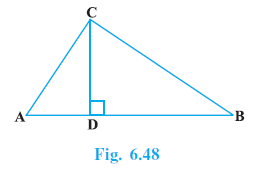
Answer:
Given:
In $\triangle$ACB, $\angle$ACB = $90^\circ$.
CD $\perp$ AB.
To Prove:
$\frac{BC^{2}}{AC^{2}}$ = $\frac{BD}{AD}$
Proof:
Consider the triangles $\triangle$ADC and $\triangle$ACB.
$\angle$ADC = $\angle$ACB = $90^\circ$
$\angle$CAD = $\angle$CAB
(Common angle)
Therefore, by AA similarity criterion,
$\triangle$ADC $\sim$ $\triangle$ACB
Since the triangles are similar, the ratio of corresponding sides is equal:
$\frac{AD}{AC} = \frac{CD}{CB} = \frac{AC}{AB}$
Taking the first and third ratios:
$\frac{AD}{AC} = \frac{AC}{AB}$
Cross-multiplying gives:
$AC^2 = AD \times AB$
Now, consider the triangles $\triangle$CDB and $\triangle$ACB.
$\angle$CDB = $\angle$ACB = $90^\circ$
$\angle$CBD = $\angle$CBA
(Common angle)
Therefore, by AA similarity criterion,
$\triangle$CDB $\sim$ $\triangle$ACB
Since the triangles are similar, the ratio of corresponding sides is equal:
$\frac{CD}{AC} = \frac{DB}{CB} = \frac{CB}{AB}$
Taking the second and third ratios:
$\frac{DB}{CB} = \frac{CB}{AB}$
Cross-multiplying gives:
$CB^2 = DB \times AB$
We need to prove $\frac{BC^2}{AC^2} = \frac{BD}{AD}$. Let's substitute the expressions for $BC^2$ and $AC^2$ we found:
$\frac{BC^2}{AC^2} = \frac{DB \times AB}{AD \times AB}$
Cancel the common term $AB$ from the numerator and denominator:
$\frac{BC^2}{AC^2} = \frac{DB}{AD}$
Rearranging the terms in the numerator and denominator of the right side gives the required result:
$\frac{BC^2}{AC^2} = \frac{BD}{AD}$
Hence Proved.
Example 11. A ladder is placed against a wall such that its foot is at a distance of 2.5 m from the wall and its top reaches a window 6 m above the ground. Find the length of the ladder.
Answer:
Given:
The distance of the foot of the ladder from the wall is $2.5$ m.
The height of the window from the ground is $6$ m.
To Find:
The length of the ladder.
Solution:
Let's visualize the scenario. The ladder, the wall, and the ground form a right-angled triangle.
Let AB be the height of the wall where the ladder reaches, and BC be the distance of the foot of the ladder from the wall. AC represents the length of the ladder.
Here, $\triangle ABC$ is a right-angled triangle with the right angle at B.
We have:
Height of the window, $AB = 6$ m.
Distance from the wall, $BC = 2.5$ m.
Length of the ladder, $AC = ?$
According to the Pythagorean theorem, in a right-angled triangle, the square of the length of the hypotenuse is equal to the sum of the squares of the other two sides.
$AC^2 = AB^2 + BC^2$
[By Pythagorean theorem]
Substitute the given values into the equation:
$AC^2 = (6)^2 + (2.5)^2$
Now, calculate the squares of the numbers:
$AC^2 = 36 + 6.25$
$AC^2 = 42.25$
To find the length of AC, we take the square root of both sides. Since length cannot be negative, we take the positive root.
$AC = \sqrt{42.25}$
$AC = 6.5$
Thus, the length of the ladder is $6.5$ meters.
The length of the ladder is $6.5$ m.
Example 12. In Fig. 6.50, if AD ⊥ BC, prove that AB2 + CD2 = BD2 + AC2 .
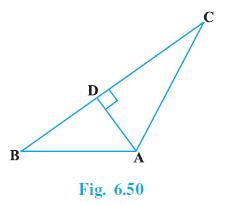
Answer:
Given:
In $\triangle$ABC, AD $\perp$ BC.
To Prove:
AB$^2$ + CD$^2$ = BD$^2$ + AC$^2$
Proof:
Since AD $\perp$ BC, $\triangle$ADB and $\triangle$ADC are right-angled triangles with the right angle at D.
In right-angled $\triangle$ADB, by the Pythagorean theorem, we have:
AB$^2$ = AD$^2$ + BD$^2$
Rearranging this equation to express AD$^2$:
AD$^2$ = AB$^2$ - BD$^2$
In right-angled $\triangle$ADC, by the Pythagorean theorem, we have:
AC$^2$ = AD$^2$ + CD$^2$
Rearranging this equation to express AD$^2$:
AD$^2$ = AC$^2$ - CD$^2$
Since both expressions are equal to AD$^2$, we can equate them:
AB$^2$ - BD$^2$ = AC$^2$ - CD$^2$
Now, rearrange the terms to get the desired result. Add BD$^2$ to both sides and add CD$^2$ to both sides:
AB$^2$ + CD$^2$ = AC$^2$ + BD$^2$
Rearranging the terms on the right side gives:
AB$^2$ + CD$^2$ = BD$^2$ + AC$^2$
Thus, the required relationship is proved.
Hence Proved.
Example 13. BL and CM are medians of a triangle ABC right angled at A. Prove that 4 (BL2 + CM2 ) = 5 BC2 .
Answer:
Given:
A triangle $\triangle ABC$ which is right-angled at A, i.e., $\angle A = 90^\circ$.
BL and CM are the medians to the sides AC and AB respectively.
To Prove:
$4 (BL^2 + CM^2 ) = 5 BC^2$
Proof:
Since BL and CM are medians of $\triangle ABC$, L is the midpoint of AC and M is the midpoint of AB.
Therefore:
$AL = LC = \frac{1}{2} AC$
$AM = MB = \frac{1}{2} AB$
Now, we apply the Pythagorean theorem to the different right-angled triangles in the figure.
In the main triangle, $\triangle ABC$ (right-angled at A):
$BC^2 = AB^2 + AC^2$
... (i)
In $\triangle ABL$ (right-angled at A):
$BL^2 = AB^2 + AL^2$
Substitute $AL = \frac{1}{2} AC$:
$BL^2 = AB^2 + \left(\frac{AC}{2}\right)^2$
$BL^2 = AB^2 + \frac{AC^2}{4}$
To eliminate the fraction, multiply the entire equation by 4:
$4BL^2 = 4AB^2 + AC^2$
... (ii)
In $\triangle ACM$ (right-angled at A):
$CM^2 = AC^2 + AM^2$
Substitute $AM = \frac{1}{2} AB$:
$CM^2 = AC^2 + \left(\frac{AB}{2}\right)^2$
$CM^2 = AC^2 + \frac{AB^2}{4}$
Multiply the entire equation by 4:
$4CM^2 = 4AC^2 + AB^2$
... (iii)
Now, we add equation (ii) and equation (iii):
$4BL^2 + 4CM^2 = (4AB^2 + AC^2) + (4AC^2 + AB^2)$
Take 4 as a common factor on the left side and group like terms on the right side:
$4(BL^2 + CM^2) = (4AB^2 + AB^2) + (AC^2 + 4AC^2)$
$4(BL^2 + CM^2) = 5AB^2 + 5AC^2$
Take 5 as a common factor on the right side:
$4(BL^2 + CM^2) = 5(AB^2 + AC^2)$
From equation (i), we know that $AB^2 + AC^2 = BC^2$. Substitute this into the equation:
$4(BL^2 + CM^2) = 5BC^2$
[Using (i)]
Hence Proved.
Example 14. O is any point inside a rectangle ABCD (see Fig. 6.52). Prove that OB2 + OD2 = OA2 + OC2 .
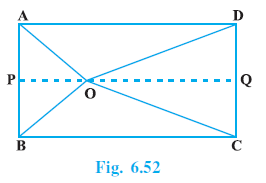
Answer:
Given:
A rectangle ABCD.
O is any point inside the rectangle ABCD.
To Prove:
$OB^2 + OD^2 = OA^2 + OC^2$.
Construction Required:
Draw a line segment PQ through the point O, parallel to the side BC, such that P lies on side AB and Q lies on side DC.
Proof:
Since ABCD is a rectangle, we know that $AB \parallel DC$ and $AD \parallel BC$. Also, all interior angles are $90^\circ$.
By our construction, $PQ \parallel BC$. Since $AB \perp BC$ and $DC \perp BC$ (as angles of a rectangle are $90^\circ$), the line PQ must also be perpendicular to AB and DC.
Therefore, $PQ \perp AB$ and $PQ \perp DC$.
This implies $\angle APQ = \angle BPQ = 90^\circ$ and $\angle DQP = \angle CQP = 90^\circ$.
This means that APQD and PBCQ are also rectangles.
Now, consider the right-angled triangles $\triangle OPA$, $\triangle OPB$, $\triangle OQC$, and $\triangle OQD$.
Applying the Pythagorean theorem to each of these triangles:
In $\triangle OPA$ (right-angled at P):
$OA^2 = AP^2 + OP^2$
... (i)
In $\triangle OPB$ (right-angled at P):
$OB^2 = BP^2 + OP^2$
... (ii)
In $\triangle OQC$ (right-angled at Q):
$OC^2 = CQ^2 + OQ^2$
... (iii)
In $\triangle OQD$ (right-angled at Q):
$OD^2 = DQ^2 + OQ^2$
... (iv)
Now, let's evaluate the Left Hand Side (LHS) of the equation we want to prove:
LHS = $OB^2 + OD^2$
Substituting from (ii) and (iv):
LHS = $(BP^2 + OP^2) + (DQ^2 + OQ^2)$
Now, let's evaluate the Right Hand Side (RHS):
RHS = $OA^2 + OC^2$
Substituting from (i) and (iii):
RHS = $(AP^2 + OP^2) + (CQ^2 + OQ^2)$
Since APQD and PBCQ are rectangles, their opposite sides are equal.
So, $AP = DQ$ and $BP = CQ$.
Let's substitute these into the expression for the RHS:
RHS = $(DQ)^2 + OP^2 + (BP)^2 + OQ^2$
Rearranging the terms:
RHS = $(BP^2 + OP^2) + (DQ^2 + OQ^2)$
Comparing this with the expression for the LHS, we see that:
LHS = RHS
Therefore, $OB^2 + OD^2 = OA^2 + OC^2$.
Hence Proved.
Alternate Solution (Using Coordinate Geometry):
Let's place the rectangle ABCD on a coordinate plane.
Let the coordinates of the vertices be:
$A = (0, b)$, $B = (a, b)$, $C = (a, 0)$, and $D = (0, 0)$.
Let the coordinates of the point O inside the rectangle be $(x, y)$.
We use the distance formula, which states that the square of the distance between two points $(x_1, y_1)$ and $(x_2, y_2)$ is $(x_2-x_1)^2 + (y_2-y_1)^2$.
Now, let's calculate the terms for the LHS: $OB^2 + OD^2$.
$OB^2 = (a-x)^2 + (b-y)^2$
$OD^2 = (0-x)^2 + (0-y)^2 = x^2 + y^2$
LHS = $OB^2 + OD^2 = (a-x)^2 + (b-y)^2 + x^2 + y^2$
Now, let's calculate the terms for the RHS: $OA^2 + OC^2$.
$OA^2 = (0-x)^2 + (b-y)^2 = x^2 + (b-y)^2$
$OC^2 = (a-x)^2 + (0-y)^2 = (a-x)^2 + y^2$
RHS = $OA^2 + OC^2 = x^2 + (b-y)^2 + (a-x)^2 + y^2$
Rearranging the terms in the RHS expression:
RHS = $(a-x)^2 + (b-y)^2 + x^2 + y^2$
By comparing the final expressions, we can see that LHS = RHS.
Therefore, $OB^2 + OD^2 = OA^2 + OC^2$.
Hence Proved.
Exercise 6.5
Question 1. Sides of triangles are given below. Determine which of them are right triangles. In case of a right triangle, write the length of its hypotenuse.
(i) 7 cm, 24 cm, 25 cm
(ii) 3 cm, 8 cm, 6 cm
(iii) 50 cm, 80 cm, 100 cm
(iv) 13 cm, 12 cm, 5 cm
Answer:
To determine if the given sides form a right triangle, we use the converse of the Pythagorean theorem. According to this theorem, if the square of the longest side of a triangle is equal to the sum of the squares of the other two sides, then the triangle is a right triangle, and the longest side is the hypotenuse.
(i) Sides are 7 cm, 24 cm, 25 cm.
The longest side is 25 cm.
Let $a = 7$ cm, $b = 24$ cm, and $c = 25$ cm.
Calculate the square of the longest side:
$c^2 = 25^2 = 625$
Calculate the sum of the squares of the other two sides:
$a^2 + b^2 = 7^2 + 24^2$
$a^2 + b^2 = 49 + 576$
$a^2 + b^2 = 625$
Compare $c^2$ and $a^2 + b^2$:
$c^2 = a^2 + b^2$ ($625 = 625$)
Since the square of the longest side is equal to the sum of the squares of the other two sides, the triangle is a right triangle.
The length of the hypotenuse is the longest side, which is 25 cm.
Conclusion: The sides 7 cm, 24 cm, and 25 cm form a right triangle. The hypotenuse is 25 cm.
(ii) Sides are 3 cm, 8 cm, 6 cm.
The longest side is 8 cm.
Let $a = 3$ cm, $b = 6$ cm, and $c = 8$ cm.
Calculate the square of the longest side:
$c^2 = 8^2 = 64$
Calculate the sum of the squares of the other two sides:
$a^2 + b^2 = 3^2 + 6^2$
$a^2 + b^2 = 9 + 36$
$a^2 + b^2 = 45$
Compare $c^2$ and $a^2 + b^2$:
$c^2 \neq a^2 + b^2$ ($64 \neq 45$)
Since the square of the longest side is not equal to the sum of the squares of the other two sides, the triangle is not a right triangle.
Conclusion: The sides 3 cm, 8 cm, and 6 cm do not form a right triangle.
(iii) Sides are 50 cm, 80 cm, 100 cm.
The longest side is 100 cm.
Let $a = 50$ cm, $b = 80$ cm, and $c = 100$ cm.
Calculate the square of the longest side:
$c^2 = 100^2 = 10000$
Calculate the sum of the squares of the other two sides:
$a^2 + b^2 = 50^2 + 80^2$
$a^2 + b^2 = 2500 + 6400$
$a^2 + b^2 = 8900$
Compare $c^2$ and $a^2 + b^2$:
$c^2 \neq a^2 + b^2$ ($10000 \neq 8900$)
Since the square of the longest side is not equal to the sum of the squares of the other two sides, the triangle is not a right triangle.
Conclusion: The sides 50 cm, 80 cm, and 100 cm do not form a right triangle.
(iv) Sides are 13 cm, 12 cm, 5 cm.
The longest side is 13 cm.
Let $a = 12$ cm, $b = 5$ cm, and $c = 13$ cm.
Calculate the square of the longest side:
$c^2 = 13^2 = 169$
Calculate the sum of the squares of the other two sides:
$a^2 + b^2 = 12^2 + 5^2$
$a^2 + b^2 = 144 + 25$
$a^2 + b^2 = 169$
Compare $c^2$ and $a^2 + b^2$:
$c^2 = a^2 + b^2$ ($169 = 169$)
Since the square of the longest side is equal to the sum of the squares of the other two sides, the triangle is a right triangle.
The length of the hypotenuse is the longest side, which is 13 cm.
Conclusion: The sides 13 cm, 12 cm, and 5 cm form a right triangle. The hypotenuse is 13 cm.
Question 2. PQR is a triangle right angled at P and M is a point on QR such that PM ⊥ QR. Show that PM2 = QM . MR.
Answer:
Given:
A triangle $\triangle PQR$ which is right-angled at P, so $\angle QPR = 90^\circ$.
M is a point on the hypotenuse QR such that PM is perpendicular to QR ($PM \perp QR$).
To Prove:
$PM^2 = QM \cdot MR$
Proof:
We will prove the result by showing that the two smaller triangles, $\triangle QMP$ and $\triangle PMR$, are similar to each other.
Let's consider $\triangle QMP$ and $\triangle PMR$.
$\angle QMP = \angle PMR$
[Each is $90^\circ$ as $PM \perp QR$]
Now let's find the other angles. In the main right-angled triangle $\triangle PQR$:
Let $\angle PQR = x$.
Since the sum of angles in a triangle is $180^\circ$:
$\angle QPR + \angle PQR + \angle PRQ = 180^\circ$
$90^\circ + x + \angle PRQ = 180^\circ$
$\angle PRQ = 90^\circ - x$
... (i)
Now consider the right-angled triangle $\triangle QMP$:
$\angle QMP + \angle PQM + \angle QPM = 180^\circ$
$90^\circ + x + \angle QPM = 180^\circ$
$\angle QPM = 90^\circ - x$
... (ii)
From equations (i) and (ii), we can see that:
$\angle PRQ = \angle QPM$
[Angles of $\triangle PMR$ and $\triangle QMP$]
So, in $\triangle QMP$ and $\triangle PMR$:
$\angle QMP = \angle PMR$ (Both $90^\circ$)
$\angle PQM = \angle RPM$ (The third angles must also be equal, or similarly can be shown to be equal to $x$)
$\angle QPM = \angle PRM$ (Both $90^\circ-x$)
By the AAA similarity criterion (or AA similarity), the triangles are similar.
$\triangle QMP \sim \triangle PMR$.
Since the triangles are similar, the ratio of their corresponding sides is equal. Corresponding sides are opposite to equal angles.
$\frac{QM \text{ (opp. } \angle QPM)}{PM \text{ (opp. } \angle PRM)} = \frac{MP \text{ (opp. } \angle PQM)}{MR \text{ (opp. } \angle RPM)} = \frac{QP \text{ (opp. } 90^\circ)}{PR \text{ (opp. } 90^\circ)}$
Taking the first two parts of the ratio:
$\frac{QM}{PM} = \frac{PM}{MR}$
Cross-multiplying the terms gives:
$PM \times PM = QM \times MR$
$PM^2 = QM \cdot MR$
Hence Proved.
Alternate Solution (Using Pythagorean Theorem):
We apply the Pythagorean theorem to the three right-angled triangles:
In $\triangle PQR$: $QR^2 = PQ^2 + PR^2 \implies (QM+MR)^2 = PQ^2 + PR^2$ ... (1)
In $\triangle PMQ$: $PQ^2 = PM^2 + QM^2$ ... (2)
In $\triangle PMR$: $PR^2 = PM^2 + MR^2$ ... (3)
Substitute the values of $PQ^2$ and $PR^2$ from (2) and (3) into equation (1):
$(QM+MR)^2 = (PM^2 + QM^2) + (PM^2 + MR^2)$
Expand the left side:
$QM^2 + MR^2 + 2(QM \cdot MR) = 2PM^2 + QM^2 + MR^2$
Cancel out the terms $QM^2$ and $MR^2$ from both sides:
$2(QM \cdot MR) = 2PM^2$
Divide both sides by 2:
$QM \cdot MR = PM^2$
Hence Proved.
Question 3. In Fig. 6.53, ABD is a triangle right angled at A and AC ⊥ BD. Show that
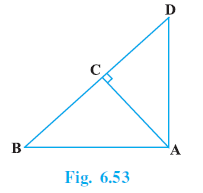
(i) AB2 = BC . BD
(ii) AC2 = BC . DC
(iii) AD2 = BD . CD
Answer:
Given:
In $\triangle$ABD, $\angle$BAD = $90^\circ$.
AC $\perp$ BD, with C on BD.
To Show:
(i) $AB^2 = BC \cdot BD$
(ii) $AC^2 = BC \cdot DC$
(iii) $AD^2 = BD \cdot CD$
Proof:
In $\triangle$ABD, since $\angle$BAD = $90^\circ$ and AC $\perp$ BD, AC is the altitude from the vertex of the right angle to the hypotenuse.
According to the theorem, if an altitude is drawn from the vertex of the right angle of a right triangle to the hypotenuse, then the triangles on either side of the altitude are similar to the whole triangle and also similar to each other.
Thus, we have:
$\triangle$ABC $\sim$ $\triangle$DBA
$\triangle$DAC $\sim$ $\triangle$DBA
$\triangle$ABC $\sim$ $\triangle$DAC
Also, since AC $\perp$ BD, $\angle$BCA = $90^\circ$ and $\angle$ACD = $90^\circ$.
In $\triangle$ABD, $\angle$B + $\angle$D = $90^\circ$ (Sum of angles in a triangle is $180^\circ$, $\angle$BAD = $90^\circ$).
In $\triangle$ABC (right-angled at C), $\angle$B + $\angle$BAC = $90^\circ$.
In $\triangle$ADC (right-angled at C), $\angle$D + $\angle$DAC = $90^\circ$.
From $\angle$B + $\angle$BAC = $90^\circ$ and $\angle$B + $\angle$D = $90^\circ$, we get $\angle$BAC = $\angle$D.
From $\angle$D + $\angle$DAC = $90^\circ$ and $\angle$B + $\angle$D = $90^\circ$, we get $\angle$DAC = $\angle$B.
(i) To show $AB^2 = BC \cdot BD$
Consider $\triangle$ABC and $\triangle$DBA.
$\angle$B = $\angle$B
(Common angle)
$\angle$BCA = $\angle$BAD
(Both are $90^\circ$)
By AA similarity criterion, $\triangle$ABC $\sim$ $\triangle$DBA.
The ratio of corresponding sides is equal:
$\frac{AB}{DB} = \frac{BC}{BA} = \frac{AC}{DA}$
Taking the first two ratios:
$\frac{AB}{DB} = \frac{BC}{AB}$
Cross-multiplying gives:
$AB \times AB = DB \times BC$
$AB^2 = BC \cdot BD$
This proves the first part.
(ii) To show $AC^2 = BC \cdot DC$
Consider $\triangle$ABC and $\triangle$DAC.
$\angle$B = $\angle$DAC
(Proved above)
$\angle$BCA = $\angle$ACD
(Both are $90^\circ$)
By AA similarity criterion, $\triangle$ABC $\sim$ $\triangle$DAC.
The ratio of corresponding sides is equal:
$\frac{AB}{DA} = \frac{BC}{AC} = \frac{AC}{DC}$
Taking the last two ratios:
$\frac{BC}{AC} = \frac{AC}{DC}$
Cross-multiplying gives:
$AC \times AC = BC \times DC$
$AC^2 = BC \cdot DC$
This proves the second part.
(iii) To show $AD^2 = BD \cdot CD$
Consider $\triangle$DAC and $\triangle$DBA.
$\angle$D = $\angle$D
(Common angle)
$\angle$ACD = $\angle$BAD
(Both are $90^\circ$)
By AA similarity criterion, $\triangle$DAC $\sim$ $\triangle$DBA.
The ratio of corresponding sides is equal:
$\frac{DA}{DB} = \frac{DC}{DA} = \frac{AC}{AB}$
Taking the first two ratios:
$\frac{DA}{DB} = \frac{DC}{DA}$
Cross-multiplying gives:
$DA \times DA = DB \times DC$
$AD^2 = BD \cdot CD$
This proves the third part.
Hence Shown.
Question 4. ABC is an isosceles triangle right angled at C. Prove that AB2 = 2AC2 .
Answer:
Given:
$\triangle ABC$ is an isosceles triangle which is right-angled at C.
This implies that $\angle C = 90^\circ$.
Since the triangle is isosceles and right-angled at C, the sides adjacent to the right angle are equal.
AC = BC
(Sides opposite to equal angles of a triangle are equal)
To Prove:
$AB^2 = 2AC^2$
Proof:
In $\triangle ABC$, the angle at C is $90^\circ$. Therefore, we can apply the Pythagorean theorem.
According to the theorem, the square of the hypotenuse (the side opposite the right angle) is equal to the sum of the squares of the other two sides.
$AB^2 = AC^2 + BC^2$
(By Pythagorean Theorem)
From the given information, we know that $AC = BC$. We can substitute BC with AC in the above equation.
$AB^2 = AC^2 + (AC)^2$
Combining the terms on the right side:
$AB^2 = 2AC^2$
Hence Proved.
Question 5. ABC is an isosceles triangle with AC = BC. If AB2 = 2AC2 , prove that ABC is a right triangle.
Answer:
Given:
$\triangle ABC$ is an isosceles triangle with $AC = BC$.
$AB^2 = 2AC^2$
(Given relation)
To Prove:
$\triangle ABC$ is a right triangle.
Proof:
We are given the relation:
$AB^2 = 2AC^2$
We can rewrite the right side of the equation as a sum:
$AB^2 = AC^2 + AC^2$
It is also given that the triangle is isosceles with $AC = BC$.
Substituting $AC = BC$ into the equation, we replace one of the $AC^2$ terms with $BC^2$:
$AB^2 = AC^2 + BC^2$
(Since AC = BC)
This equation is in the form of the Pythagorean theorem, which states $c^2 = a^2 + b^2$.
According to the Converse of the Pythagorean Theorem, if the square of one side of a triangle is equal to the sum of the squares of the other two sides, then the angle opposite the first side is a right angle.
In our case, the square of side AB is equal to the sum of the squares of sides AC and BC. The angle opposite to the side AB is $\angle C$.
Therefore, by the converse of the Pythagorean theorem, $\angle C = 90^\circ$.
Since one of the angles of $\triangle ABC$ is $90^\circ$, it is a right triangle.
Hence Proved.
Question 6. ABC is an equilateral triangle of side 2a. Find each of its altitudes.
Answer:
Given:
$\triangle ABC$ is an equilateral triangle.
The length of each side is $2a$. So, $AB = BC = AC = 2a$.
To Find:
The length of each altitude of the triangle.
Solution:
In an equilateral triangle, all three altitudes have the same length.
Let's draw an altitude AD from vertex A to the side BC. By definition of an altitude, $AD \perp BC$.
A key property of an equilateral triangle is that the altitude from a vertex is also the median to the opposite side. This means the altitude AD bisects the side BC.
Therefore, D is the midpoint of BC.
$BD = DC = \frac{1}{2} BC = \frac{1}{2} (2a) = a$.
Now, consider the triangle $\triangle ADB$. Since $AD \perp BC$, $\angle ADB = 90^\circ$. So, $\triangle ADB$ is a right-angled triangle.
We can apply the Pythagorean theorem to $\triangle ADB$:
$AB^2 = AD^2 + BD^2$
(By Pythagorean Theorem)
Substitute the known values, $AB = 2a$ and $BD = a$:
$(2a)^2 = AD^2 + (a)^2$
$4a^2 = AD^2 + a^2$
To find the length of the altitude AD, we rearrange the equation:
$AD^2 = 4a^2 - a^2$
$AD^2 = 3a^2$
Taking the square root of both sides (length must be positive):
$AD = \sqrt{3a^2}$
$AD = a\sqrt{3}$
Since all altitudes of an equilateral triangle are equal, the length of each altitude is $a\sqrt{3}$.
The length of each altitude is $a\sqrt{3}$.
Question 7. Prove that the sum of the squares of the sides of a rhombus is equal to the sum of the squares of its diagonals.
Answer:
Given:
A rhombus ABCD with sides AB, BC, CD, DA and diagonals AC, BD.
To Prove:
$AB^2 + BC^2 + CD^2 + DA^2 = AC^2 + BD^2$.
Proof:
We will use the properties of a rhombus:
1. All four sides are equal in length: $AB = BC = CD = DA$.
2. The diagonals bisect each other at right angles ($90^\circ$).
Let the diagonals AC and BD intersect at point O. From property 2, we have:
$AO = OC = \frac{1}{2} AC$
$BO = OD = \frac{1}{2} BD$
And, $\angle AOB = \angle BOC = \angle COD = \angle DOA = 90^\circ$.
The diagonals divide the rhombus into four congruent right-angled triangles.
Let's consider one of these triangles, $\triangle AOB$. It is right-angled at O.
Applying the Pythagorean theorem to $\triangle AOB$:
$AB^2 = AO^2 + BO^2$
(By Pythagorean Theorem)
Substitute the expressions for AO and BO in terms of the diagonals:
$AB^2 = \left(\frac{1}{2} AC\right)^2 + \left(\frac{1}{2} BD\right)^2$
$AB^2 = \frac{AC^2}{4} + \frac{BD^2}{4}$
Multiply the entire equation by 4 to clear the denominators:
$4AB^2 = AC^2 + BD^2$
... (i)
The sum of the squares of the sides of the rhombus is $AB^2 + BC^2 + CD^2 + DA^2$.
Since all sides are equal ($AB = BC = CD = DA$), we can write this sum as:
$AB^2 + AB^2 + AB^2 + AB^2 = 4AB^2$.
Substituting this into equation (i), we get:
$AB^2 + BC^2 + CD^2 + DA^2 = AC^2 + BD^2$
This proves that the sum of the squares of the sides of a rhombus is equal to the sum of the squares of its diagonals.
Hence Proved.
Question 8. In Fig. 6.54, O is a point in the interior of a triangle ABC, OD ⊥ BC, OE ⊥AC and OF ⊥AB. Show that
(i) OA2 + OB2 + OC2 – OD2 – OE2 – OF2 = AF2 + BD2 + CE2 ,
(ii) AF2 + BD2 + CE2 = AE2 + CD2 + BF2 .
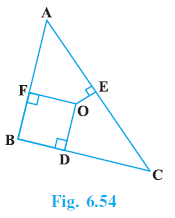
Answer:
Given:
A triangle $\triangle ABC$ with a point O in its interior.
Perpendiculars from O to the sides are drawn such that $OD \perp BC$, $OE \perp AC$, and $OF \perp AB$.
To Prove:
(i) $OA^2 + OB^2 + OC^2 – OD^2 – OE^2 – OF^2 = AF^2 + BD^2 + CE^2$
(ii) $AF^2 + BD^2 + CE^2 = AE^2 + CD^2 + BF^2$
Construction Required:
Join the point O to the vertices A, B, and C of the triangle.
Proof:
The construction and the given perpendiculars create several right-angled triangles. We will apply the Pythagorean theorem to these triangles.
(i) To prove $OA^2 + OB^2 + OC^2 – OD^2 – OE^2 – OF^2 = AF^2 \ $$ + BD^2 + CE^2$
Consider the right-angled triangles $\triangle OFA$, $\triangle ODB$, and $\triangle OEC$.
In right-angled $\triangle OFA$ (right-angled at F):
$OA^2 = OF^2 + AF^2$
[By Pythagorean Theorem]
Rearranging this gives:
$AF^2 = OA^2 - OF^2$
... (1)
In right-angled $\triangle ODB$ (right-angled at D):
$OB^2 = OD^2 + BD^2$
[By Pythagorean Theorem]
Rearranging this gives:
$BD^2 = OB^2 - OD^2$
... (2)
In right-angled $\triangle OEC$ (right-angled at E):
$OC^2 = OE^2 + CE^2$
[By Pythagorean Theorem]
Rearranging this gives:
$CE^2 = OC^2 - OE^2$
... (3)
Adding equations (1), (2), and (3):
$AF^2 + BD^2 + CE^2 = (OA^2 - OF^2) + (OB^2 - OD^2) + (OC^2 - OE^2)$
Grouping the terms, we get:
$AF^2 + BD^2 + CE^2 = OA^2 + OB^2 + OC^2 - OD^2 - OE^2 - OF^2$
This is the required result for part (i).
Hence Proved (i).
(ii) To prove $AF^2 + BD^2 + CE^2 = AE^2 + CD^2 + BF^2$
From part (i), we have already established that:
$AF^2 + BD^2 + CE^2 = OA^2 + OB^2 + OC^2 - OD^2 - OE^2 - OF^2$
Now, consider the other set of right-angled triangles: $\triangle OEA$, $\triangle ODC$, and $\triangle OFB$.
In right-angled $\triangle OEA$ (right-angled at E):
$OA^2 = OE^2 + AE^2$
[By Pythagorean Theorem]
Rearranging this gives:
$AE^2 = OA^2 - OE^2$
... (4)
In right-angled $\triangle ODC$ (right-angled at D):
$OC^2 = OD^2 + CD^2$
[By Pythagorean Theorem]
Rearranging this gives:
$CD^2 = OC^2 - OD^2$
... (5)
In right-angled $\triangle OFB$ (right-angled at F):
$OB^2 = OF^2 + BF^2$
[By Pythagorean Theorem]
Rearranging this gives:
$BF^2 = OB^2 - OF^2$
... (6)
Adding equations (4), (5), and (6):
$AE^2 + CD^2 + BF^2 = (OA^2 - OE^2) + (OC^2 - OD^2) + (OB^2 - OF^2)$
Grouping the terms, we get:
$AE^2 + CD^2 + BF^2 = OA^2 + OB^2 + OC^2 - OD^2 - OE^2 - OF^2$
Now, comparing equation (A) and equation (B), we see that the right-hand sides of both equations are identical.
Therefore, their left-hand sides must be equal.
$AF^2 + BD^2 + CE^2 = AE^2 + CD^2 + BF^2$
Hence Proved (ii).
Question 9. A ladder 10 m long reaches a window 8 m above the ground. Find the distance of the foot of the ladder from base of the wall.
Answer:
Given:
Length of the ladder = $10$ m.
Height of the window from the ground = $8$ m.
To Find:
The distance of the foot of the ladder from the base of the wall.
Solution:
Let the ladder, the wall, and the ground form a right-angled triangle, with the wall being perpendicular to the ground.
Let the length of the ladder (hypotenuse) be $l = 10$ m.
Let the height of the window on the wall (perpendicular) be $h = 8$ m.
Let the distance of the foot of the ladder from the base of the wall (base) be $d$ m.
According to the Pythagorean theorem, in a right-angled triangle, the square of the hypotenuse is equal to the sum of the squares of the other two sides.
$l^2 = h^2 + d^2$
(By Pythagorean Theorem)
Substitute the given values into the equation:
$(10)^2 = (8)^2 + d^2$
$100 = 64 + d^2$
To find $d^2$, rearrange the equation:
$d^2 = 100 - 64$
$d^2 = 36$
Now, take the square root of both sides. Since distance must be a positive value, we take the positive root.
$d = \sqrt{36}$
$d = 6$
Therefore, the distance of the foot of the ladder from the base of the wall is $6$ metres.
The distance of the foot of the ladder from the base of the wall is $6$ m.
Question 10. A guy wire attached to a vertical pole of height 18 m is 24 m long and has a stake attached to the other end. How far from the base of the pole should the stake be driven so that the wire will be taut?
Answer:
Given:
Height of the vertical pole = $18$ m.
Length of the guy wire = $24$ m.
To Find:
The distance from the base of the pole where the stake should be driven.
Solution:
The vertical pole, the ground, and the taut guy wire form a right-angled triangle, with the pole being perpendicular to the ground.
Let $h$ be the height of the pole (perpendicular), $h = 18$ m.
Let $l$ be the length of the guy wire (hypotenuse), $l = 24$ m.
Let $d$ be the distance from the base of the pole to the stake (base).
By the Pythagorean theorem:
$l^2 = h^2 + d^2$
Substitute the given values:
$(24)^2 = (18)^2 + d^2$
$576 = 324 + d^2$
Rearrange the equation to solve for $d^2$:
$d^2 = 576 - 324$
$d^2 = 252$
Take the square root of both sides:
$d = \sqrt{252}$
To simplify $\sqrt{252}$, we find its prime factors:
$\begin{array}{c|cc} 2 & 252 \\ \hline 2 & 126 \\ \hline 3 & 63 \\ \hline 3 & 21 \\ \hline 7 & 7 \\ \hline & 1 \end{array}$
So, $252 = 2^2 \times 3^2 \times 7$.
$d = \sqrt{2^2 \times 3^2 \times 7}$
$d = \sqrt{2^2} \times \sqrt{3^2} \times \sqrt{7}$
$d = 2 \times 3 \times \sqrt{7}$
$d = 6\sqrt{7}$
Therefore, the stake should be driven $6\sqrt{7}$ metres from the base of the pole.
The stake should be driven $6\sqrt{7}$ m away from the base of the pole.
Question 11. An aeroplane leaves an airport and flies due north at a speed of 1000 km per hour. At the same time, another aeroplane leaves the same airport and flies due west at a speed of 1200 km per hour. How far apart will be the two planes after $1\frac{1}{2}$ hours.
Answer:
Given:
Speed of the first aeroplane (flying north) = $1000$ km/h.
Speed of the second aeroplane (flying west) = $1200$ km/h.
Time elapsed = $1\frac{1}{2}$ hours = $1.5$ hours = $\frac{3}{2}$ hours.
To Find:
The distance between the two aeroplanes after $1\frac{1}{2}$ hours.
Solution:
First, calculate the distance each aeroplane has traveled in $1.5$ hours using the formula: Distance = Speed × Time.
Distance traveled by the first aeroplane (due north):
$d_1 = 1000 \text{ km/h} \times 1.5 \text{ h} = 1500 \text{ km}$.
Distance traveled by the second aeroplane (due west):
$d_2 = 1200 \text{ km/h} \times 1.5 \text{ h} = 1800 \text{ km}$.
The paths of the aeroplanes are due north and due west, which are perpendicular directions. Therefore, their positions and the airport form a right-angled triangle.
Let the airport be O, the position of the first plane be A (north of O), and the position of the second plane be B (west of O). We have a right-angled triangle $\triangle AOB$ with $\angle AOB = 90^\circ$.
$OA = 1500$ km and $OB = 1800$ km.
The distance between the two planes is the hypotenuse AB. By the Pythagorean theorem:
$AB^2 = OA^2 + OB^2$
Substitute the distances:
$AB^2 = (1500)^2 + (1800)^2$
$AB^2 = 2,250,000 + 3,240,000$
$AB^2 = 5,490,000$
$AB = \sqrt{5,490,000} = \sqrt{549 \times 10000}$
$AB = 100 \sqrt{549}$
To simplify $\sqrt{549}$, we find its prime factors:
$\begin{array}{c|cc} 3 & 549 \\ \hline 3 & 183 \\ \hline 61 & 61 \\ \hline & 1 \end{array}$
$549 = 9 \times 61 = 3^2 \times 61$.
So, $\sqrt{549} = \sqrt{3^2 \times 61} = 3\sqrt{61}$.
Therefore, the distance AB is:
$AB = 100 \times 3\sqrt{61} = 300\sqrt{61}$ km.
The distance between the two planes after $1\frac{1}{2}$ hours is $300\sqrt{61}$ km.
Question 12. Two poles of heights 6 m and 11 m stand on a plane ground. If the distance between the feet of the poles is 12 m, find the distance between their tops.
Answer:
Given:
Height of the first pole = $6$ m.
Height of the second pole = $11$ m.
Distance between the feet of the poles = $12$ m.
To Find:
The distance between the tops of the poles.
Solution:
Let the two poles be AB and CD, standing on level ground AC. Let A and C be the feet, and B and D be the tops.
Height of pole AB = $6$ m.
Height of pole CD = $11$ m.
Distance between feet, AC = $12$ m.
We need to find the distance between the tops, BD.
Draw a line BE parallel to the ground AC from the top of the shorter pole (B) to the taller pole (CD). This line intersects CD at E.
The figure ABEC forms a rectangle because AB and CE are vertical (parallel) and AC and BE are horizontal (parallel).
Therefore, $BE = AC = 12$ m, and $CE = AB = 6$ m.
Now, we can find the length of the segment DE on the taller pole:
$DE = CD - CE = 11 \text{ m} - 6 \text{ m} = 5 \text{ m}$.
Consider the triangle $\triangle BED$. Since BE is horizontal and DE is vertical, $\angle BED = 90^\circ$. So, $\triangle BED$ is a right-angled triangle.
By the Pythagorean theorem:
$BD^2 = BE^2 + DE^2$
Substitute the values we found:
$BD^2 = (12)^2 + (5)^2$
$BD^2 = 144 + 25$
$BD^2 = 169$
Taking the square root of both sides:
$BD = \sqrt{169}$
$BD = 13$
The distance between the tops of the poles is $13$ m.
The distance between their tops is $13$ m.
Question 13. D and E are points on the sides CA and CB respectively of a triangle ABC right angled at C. Prove that AE2 + BD2 = AB2 + DE2
Answer:
Given:
A triangle $\triangle ABC$ right-angled at C ($\angle C = 90^\circ$).
D is a point on side CA.
E is a point on side CB.
To Prove:
$AE^2 + BD^2 = AB^2 + DE^2$
Proof:
We can apply the Pythagorean theorem to the four right-angled triangles in the figure: $\triangle ACE$, $\triangle BCD$, $\triangle ABC$, and $\triangle DCE$.
Let's express the terms in the Left Hand Side (LHS) of the equation.
LHS = $AE^2 + BD^2$.
In right-angled $\triangle ACE$:
$AE^2 = AC^2 + CE^2$
... (i)
In right-angled $\triangle BCD$:
$BD^2 = BC^2 + CD^2$
... (ii)
Adding (i) and (ii):
LHS = $AE^2 + BD^2 = (AC^2 + CE^2) + (BC^2 + CD^2)$
Rearranging the terms:
$AE^2 + BD^2 = (AC^2 + BC^2) + (CD^2 + CE^2)$
... (iii)
Now, let's express the terms in the Right Hand Side (RHS) of the equation.
RHS = $AB^2 + DE^2$.
In right-angled $\triangle ABC$:
$AB^2 = AC^2 + BC^2$
... (iv)
In right-angled $\triangle DCE$:
$DE^2 = CD^2 + CE^2$
... (v)
Adding (iv) and (v):
$AB^2 + DE^2 = (AC^2 + BC^2) + (CD^2 + CE^2)$
... (vi)
By comparing the final expressions in equation (iii) and equation (vi), we can see that the right-hand sides are identical.
Therefore, LHS = RHS.
$AE^2 + BD^2 = AB^2 + DE^2$
Hence Proved.
Question 14. The perpendicular from A on side BC of a ∆ ABC intersects BC at D such that DB = 3 CD (see Fig. 6.55). Prove that 2 AB2 = 2 AC2 + BC2 .
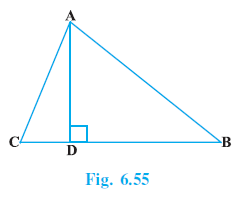
Answer:
Given:
In $\triangle$ABC, AD $\perp$ BC, where D is a point on BC.
DB = 3 CD.
To Prove:
$2 AB^2 = 2 AC^2 + BC^2$
Proof:
Since AD $\perp$ BC, $\triangle$ADB and $\triangle$ADC are right-angled triangles with the right angle at D.
In right-angled $\triangle$ADB, by the Pythagorean theorem:
$AB^2 = AD^2 + DB^2$
In right-angled $\triangle$ADC, by the Pythagorean theorem:
$AC^2 = AD^2 + CD^2$
From this equation, we can express $AD^2$ as:
$AD^2 = AC^2 - CD^2$
Substitute the expression for $AD^2$ from the second equation into the first equation:
$AB^2 = (AC^2 - CD^2) + DB^2$
$AB^2 = AC^2 - CD^2 + DB^2$
We are given that DB = 3 CD.
The length of side BC is the sum of BD and CD (since D lies on BC):
$BC = BD + CD$
Substitute DB = 3 CD into this equation:
$BC = 3 CD + CD$
$BC = 4 CD$
From this, we can express CD in terms of BC:
$CD = \frac{BC}{4}$
Now, substitute this value of CD back into the equation DB = 3 CD:
$DB = 3 \left(\frac{BC}{4}\right)$
$DB = \frac{3 BC}{4}$
Now, substitute the expressions for CD and DB in terms of BC into the equation $AB^2 = AC^2 - CD^2 + DB^2$:
$AB^2 = AC^2 - \left(\frac{BC}{4}\right)^2 + \left(\frac{3 BC}{4}\right)^2$
$AB^2 = AC^2 - \frac{BC^2}{16} + \frac{9 BC^2}{16}$
Combine the terms with $BC^2$:
$AB^2 = AC^2 + \left(\frac{9 BC^2}{16} - \frac{BC^2}{16}\right)$
$AB^2 = AC^2 + \frac{9 BC^2 - BC^2}{16}$
$AB^2 = AC^2 + \frac{8 BC^2}{16}$
Simplify the fraction:
$AB^2 = AC^2 + \frac{1}{2} BC^2$
To eliminate the fraction, multiply the entire equation by 2:
$2 \times AB^2 = 2 \times \left(AC^2 + \frac{1}{2} BC^2\right)$
$2 AB^2 = 2 AC^2 + 2 \times \frac{1}{2} BC^2$
$2 AB^2 = 2 AC^2 + BC^2$
Thus, the required relationship is proved.
Hence Proved.
Question 15. In an equilateral triangle ABC, D is a point on side BC such that BD = $\frac{1}{3}$ BC. Prove that 9 AD2 = 7 AB2 .
Answer:
Given:
$\triangle ABC$ is an equilateral triangle.
D is a point on side BC such that $BD = \frac{1}{3} BC$.
To Prove:
$9 AD^2 = 7 AB^2$
Construction:
Draw an altitude AE from vertex A to the side BC ($AE \perp BC$).
Proof:
Let the side length of the equilateral triangle be $s$. So, $AB = BC = AC = s$.
In an equilateral triangle, the altitude AE is also the median to the side BC. Therefore, E is the midpoint of BC.
$BE = \frac{1}{2} BC = \frac{s}{2}$.
We are given that $BD = \frac{1}{3} BC = \frac{s}{3}$.
Now, we can find the length of the segment DE:
$DE = BE - BD = \frac{s}{2} - \frac{s}{3}$
$DE = \frac{3s - 2s}{6} = \frac{s}{6}$.
Consider the right-angled triangle $\triangle ABE$. By the Pythagorean theorem:
$AB^2 = AE^2 + BE^2$
$s^2 = AE^2 + \left(\frac{s}{2}\right)^2$
$AE^2 = s^2 - \frac{s^2}{4} = \frac{3s^2}{4}$.
Now, consider the right-angled triangle $\triangle ADE$. By the Pythagorean theorem:
$AD^2 = AE^2 + DE^2$
Substitute the values we found for $AE^2$ and $DE^2$:
$AD^2 = \left(\frac{3s^2}{4}\right) + \left(\frac{s}{6}\right)^2$
$AD^2 = \frac{3s^2}{4} + \frac{s^2}{36}$
To add the fractions, we find a common denominator, which is 36.
$AD^2 = \frac{9 \times 3s^2}{36} + \frac{s^2}{36}$
$AD^2 = \frac{27s^2 + s^2}{36} = \frac{28s^2}{36}$
Simplify the fraction by dividing the numerator and denominator by 4:
$AD^2 = \frac{7s^2}{9}$
Multiply both sides by 9:
$9 AD^2 = 7s^2$
Since the side length $s = AB$, we can substitute $s^2$ with $AB^2$:
$9 AD^2 = 7 AB^2$
Hence Proved.
Question 16. In an equilateral triangle, prove that three times the square of one side is equal to four times the square of one of its altitudes.
Answer:
Given:
An equilateral triangle (let's call it $\triangle ABC$).
To Prove:
Three times the square of one side is equal to four times the square of one of its altitudes.
That is, if 's' is the side and 'h' is the altitude, we need to prove $3s^2 = 4h^2$.
Construction:
Draw an altitude AD from vertex A to the opposite side BC.
Proof:
Let the side length of the equilateral triangle $\triangle ABC$ be $s$. So, $AB = BC = AC = s$.
Let the length of the altitude AD be $h$.
In an equilateral triangle, the altitude from a vertex bisects the opposite side. Therefore, D is the midpoint of BC.
$BD = \frac{1}{2} BC = \frac{s}{2}$.
Since AD is an altitude, $\triangle ADB$ is a right-angled triangle with $\angle ADB = 90^\circ$.
Applying the Pythagorean theorem to $\triangle ADB$:
$AB^2 = AD^2 + BD^2$
Substitute the terms with $s$ and $h$:
$s^2 = h^2 + \left(\frac{s}{2}\right)^2$
$s^2 = h^2 + \frac{s^2}{4}$
Rearrange the equation to group the terms with $s^2$:
$s^2 - \frac{s^2}{4} = h^2$
$\frac{4s^2 - s^2}{4} = h^2$
$\frac{3s^2}{4} = h^2$
Multiply both sides by 4 to eliminate the denominator:
$3s^2 = 4h^2$
This proves that three times the square of the side is equal to four times the square of the altitude.
Hence Proved.
Question 17. Tick the correct answer and justify : In ∆ABC, AB = 6$\sqrt{3}$ cm, AC = 12 cm and BC = 6 cm. The angle B is :
(A) 120°
(B) 60°
(C) 90°
(D) 45°
Answer:
Given:
In $\triangle ABC$, the side lengths are:
- $AB = 6\sqrt{3}$ cm
- $AC = 12$ cm
- $BC = 6$ cm
To Find:
The measure of angle B.
Justification:
To determine the type of triangle, we can check if it satisfies the Pythagorean theorem. We will use the Converse of the Pythagorean Theorem.
First, let's find the square of each side length:
$AB^2 = (6\sqrt{3})^2 = 6^2 \times (\sqrt{3})^2 = 36 \times 3 = 108$
$AC^2 = (12)^2 = 144$
$BC^2 = (6)^2 = 36$
The longest side is AC, with a length of 12 cm. Its square is $AC^2 = 144$.
Now, let's find the sum of the squares of the other two sides, AB and BC:
$AB^2 + BC^2 = 108 + 36 = 144$
We observe that:
$AC^2 = AB^2 + BC^2$
(Since $144 = 144$)
Since the square of the longest side (AC) is equal to the sum of the squares of the other two sides (AB and BC), the triangle is a right-angled triangle.
According to the converse of the Pythagorean theorem, the angle opposite the longest side (the hypotenuse) is the right angle ($90^\circ$).
The angle opposite to the side AC is $\angle B$.
Therefore, $\angle B = 90^\circ$.
Conclusion:
The correct option is (C) 90°.
Exercise 6.6 (Optional)
Question 1. In Fig. 6.56, PS is the bisector of ∠QPR of ∆ PQR. Prove that $\frac{QS}{SR}$ = $\frac{PQ}{PR}$ .
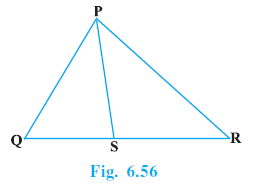
Answer:
This is a proof of the Angle Bisector Theorem.
Given:
In $\triangle PQR$, the line segment PS is the bisector of $\angle QPR$.
To Prove:
$\frac{QS}{SR} = \frac{PQ}{PR}$.
Construction:
Draw a line through the vertex R parallel to the angle bisector PS. Extend the side QP to meet this line at a point T.
Proof:
By construction, we have $PS \parallel RT$.
Now consider $\triangle QRT$. The line segment PS is parallel to the side RT and intersects the other two sides QR and QT.
By the Basic Proportionality Theorem (Thales' Theorem), we can state that:
$\frac{QS}{SR} = \frac{QP}{PT}$
... (i)
Now we need to show that $PT = PR$.
Since $PS \parallel RT$, and PR is a transversal line intersecting them:
$\angle SPR = \angle PRT$
[Alternate Interior Angles]
Also, since $PS \parallel RT$, and QT is a transversal line intersecting them:
$\angle QPS = \angle PTR$
[Corresponding Angles]
It is given that PS is the angle bisector of $\angle QPR$, which means:
$\angle QPS = \angle SPR$
[Given]
From the above three angle relations, we can conclude that:
$\angle PRT = \angle PTR$.
In $\triangle PRT$, since two angles are equal, the sides opposite to these equal angles must also be equal.
$PR = PT$
[Sides opposite to equal angles] ... (ii)
Now, substitute the result from (ii) into our proportion from (i):
$\frac{QS}{SR} = \frac{QP}{PR}$
Since QP is the same as PQ, we have:
$\frac{QS}{SR} = \frac{PQ}{PR}$
Hence Proved.
Question 2. In Fig. 6.57, D is a point on hypotenuse AC of ∆ABC, such that BD ⊥AC, DM ⊥ BC and DN ⊥ AB. Prove that :
(i) DM2 = DN . MC
(ii) DN2 = DM . AN

Answer:
Given:
In $\triangle ABC$, $\angle B = 90^\circ$.
$BD \perp AC$, $DM \perp BC$, and $DN \perp AB$.
To Prove:
(i) $DM^2 = DN \cdot MC$
(ii) $DN^2 = DM \cdot AN$
Proof:
First, let's analyze the quadrilateral BNDM. We have:
$\angle NBM = 90^\circ$ (Given for $\triangle ABC$)
$\angle DNB = 90^\circ$ (Given $DN \perp AB$)
$\angle DMB = 90^\circ$ (Given $DM \perp BC$)
Since three angles are $90^\circ$, the fourth angle $\angle NDM$ must also be $90^\circ$. Thus, BNDM is a rectangle.
The properties of a rectangle imply that opposite sides are equal:
$DN = BM$ and $DM = BN$
... (1)
Also, since $BD \perp AC$, we know that $\triangle BDC$ is a right-angled triangle. In $\triangle BDC$, $DM \perp BC$. This setup means $\triangle CMD \sim \triangle DMB$.
Let's prove this similarity. Let $\angle C = x$. Then in right $\triangle BDC$, $\angle CBD = 90^\circ - x$.
In right $\triangle CMD$, $\angle CDM = 90^\circ - x$.
In right $\triangle DMB$, $\angle BDM = 90^\circ - \angle CBD = 90^\circ - (90^\circ - x) = x$.
In $\triangle CMD$ and $\triangle DMB$:
$\angle C = \angle BDM = x$
$\angle CDM = \angle CBD = 90^\circ - x$
$\angle CMD = \angle DMB = 90^\circ$
Therefore, $\triangle CMD \sim \triangle DMB$ by AAA similarity.
(i) To prove $DM^2 = DN \cdot MC$
From the similarity $\triangle CMD \sim \triangle DMB$, the ratio of corresponding sides is equal:
$\frac{CM}{DM} = \frac{MD}{MB} = \frac{CD}{DB}$
Taking the first two parts of the ratio:
$\frac{CM}{DM} = \frac{DM}{MB}$
Cross-multiplying gives: $DM^2 = CM \cdot MB$
From (1), we know $BM = DN$. Substituting this into the equation:
$DM^2 = CM \cdot DN$, which can be written as $DM^2 = DN \cdot MC$.
Hence Proved (i).
(ii) To prove $DN^2 = DM \cdot AN$
Similarly, since $BD \perp AC$, we have a right-angled triangle $\triangle BDA$. In this triangle, $DN \perp AB$. This setup means $\triangle AND \sim \triangle DNB$.
Let's prove this similarity. Let $\angle A = y$. Then in right $\triangle BDA$, $\angle ABD = 90^\circ - y$.
In right $\triangle AND$, $\angle ADN = 90^\circ - y$.
In right $\triangle DNB$, $\angle NDB = 90^\circ - \angle ABD = 90^\circ - (90^\circ - y) = y$.
In $\triangle AND$ and $\triangle DNB$:
$\angle A = \angle NDB = y$
$\angle ADN = \angle ABD = 90^\circ - y$
$\angle AND = \angle DNB = 90^\circ$
Therefore, $\triangle AND \sim \triangle DNB$ by AAA similarity.
From this similarity, the ratio of corresponding sides is equal:
$\frac{AN}{DN} = \frac{ND}{NB} = \frac{AD}{DB}$
Taking the first two parts of the ratio:
$\frac{AN}{DN} = \frac{DN}{NB}$
Cross-multiplying gives: $DN^2 = AN \cdot NB$
From (1), we know $BN = DM$. Substituting this into the equation:
$DN^2 = AN \cdot DM$, which can be written as $DN^2 = DM \cdot AN$.
Hence Proved (ii).
Question 3. In Fig. 6.58, ABC is a triangle in which ∠ABC > 90° and AD ⊥ CB produced. Prove that AC2 = AB2 + BC2 + 2 BC . BD.
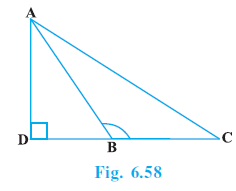
Answer:
This is a proof of the Obtuse Angle Theorem, a generalization of the Pythagorean theorem.
Given:
A triangle $\triangle ABC$ where $\angle ABC$ is an obtuse angle ($\angle ABC > 90^\circ$).
AD is an altitude to the side CB produced, so $AD \perp CD$.
To Prove:
$AC^2 = AB^2 + BC^2 + 2 BC \cdot BD$.
Proof:
Since $AD \perp CD$, the triangles $\triangle ADC$ and $\triangle ADB$ are right-angled triangles.
First, consider the larger right-angled triangle, $\triangle ADC$.
By the Pythagorean theorem:
$AC^2 = AD^2 + DC^2$
... (i)
From the figure, the length of the side DC is the sum of the lengths of BC and BD.
$DC = BC + BD$.
Substitute this into equation (i):
$AC^2 = AD^2 + (BC + BD)^2$
Expand the squared term:
$AC^2 = AD^2 + (BC^2 + BD^2 + 2 BC \cdot BD)$
Rearrange the terms by grouping $AD^2$ and $BD^2$ together:
$AC^2 = (AD^2 + BD^2) + BC^2 + 2 BC \cdot BD$
... (ii)
Now, consider the smaller right-angled triangle, $\triangle ADB$.
By the Pythagorean theorem:
$AB^2 = AD^2 + BD^2$
... (iii)
Finally, substitute the expression for $(AD^2 + BD^2)$ from equation (iii) into equation (ii):
$AC^2 = (AB^2) + BC^2 + 2 BC \cdot BD$
This gives us the desired result:
$AC^2 = AB^2 + BC^2 + 2 BC \cdot BD$
Hence Proved.
Question 4. In Fig. 6.59, ABC is a triangle in which ∠ ABC < 90° and AD ⊥ BC. Prove that AC2 = AB2 + BC2 – 2 BC . BD.
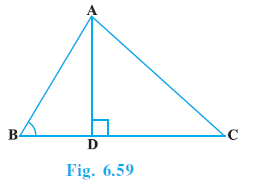
Answer:
Given:
In $\triangle$ ABC, $\angle$ ABC < $90^\circ$.
AD $\perp$ BC, with D on BC.
To Prove:
$AC^2 = AB^2 + BC^2 – 2 BC \cdot BD$.
Proof:
Since AD $\perp$ BC, $\triangle$ ADB and $\triangle$ ADC are right-angled triangles with the right angle at D.
Consider the right-angled triangle $\triangle$ ADB.
By the Pythagorean theorem, the square of the hypotenuse AB is equal to the sum of the squares of the other two sides AD and BD.
AB$^2$ = AD$^2$ + BD$^2$
(Pythagorean theorem in $\triangle$ ADB)
Rearranging this equation to express AD$^2$:
AD$^2$ = AB$^2$ - BD$^2$
... (1)
Now, consider the right-angled triangle $\triangle$ ADC.
By the Pythagorean theorem, the square of the hypotenuse AC is equal to the sum of the squares of the other two sides AD and DC.
AC$^2$ = AD$^2$ + DC$^2$
(Pythagorean theorem in $\triangle$ ADC)
From the figure, since D lies on the line segment BC, the length BC is the sum of BD and DC, or the difference depending on the position of D. As $\angle$ ABC < $90^\circ$ and AD $\perp$ BC, point D must lie between B and C if $\angle$ACB is acute, or on the extension of BC if $\angle$ACB is obtuse. The diagram shows D is on BC itself, so $BC = BD + DC$. Thus, $DC = BC - BD$.
DC = BC - BD
Substitute this expression for DC into the equation for $AC^2$:
$AC^2 = AD^2 + (BC - BD)^2$
Expand the term $(BC - BD)^2$:
$(BC - BD)^2 = BC^2 + BD^2 - 2 \cdot BC \cdot BD$
Substitute this back into the equation for $AC^2$:
$AC^2 = AD^2 + BC^2 + BD^2 - 2 BC \cdot BD$
We can group the terms $AD^2$ and $BD^2$:
$AC^2 = (AD^2 + BD^2) + BC^2 - 2 BC \cdot BD$
From equation (1), we know that $AD^2 + BD^2 = AB^2$. Substitute this into the equation:
$AC^2 = AB^2 + BC^2 - 2 BC \cdot BD$
Thus, the required relationship is proved.
Hence Proved.
Question 5. In Fig. 6.60, AD is a median of a triangle ABC and AM ⊥ BC. Prove that :
(i) AC2 = AD2 + BC . DM + $\left( \frac{BC}{2}\right)^{2}$
(ii) AB2 = AD2 – BC . DM + $\left( \frac{BC}{2}\right)^{2}$
(iii) AC2 + AB2 = 2 AD2 + $\frac{1}{2}$ BC2

Answer:
Given:
In $\triangle ABC$:
AD is the median to side BC. This means D is the midpoint of BC, so $BD = DC = \frac{1}{2}BC$.
AM is the altitude to side BC, so $AM \perp BC$ and $\angle AMB = \angle AMC = 90^\circ$.
To Prove:
(i) $AC^2 = AD^2 + BC \cdot DM + \left(\frac{BC}{2}\right)^2$
(ii) $AB^2 = AD^2 – BC \cdot DM + \left(\frac{BC}{2}\right)^2$
(iii) $AC^2 + AB^2 = 2 AD^2 + \frac{1}{2} BC^2$ (This is Apollonius's Theorem)
Proof:
We will use the Pythagorean theorem on the three right-angled triangles: $\triangle AMC$, $\triangle AMB$, and $\triangle AMD$.
(i) Proof for $AC^2 = AD^2 + BC \cdot DM + \left(\frac{BC}{2}\right)^2$
In the right-angled triangle $\triangle AMC$:
$AC^2 = AM^2 + MC^2$
(By Pythagorean Theorem)
From the figure, we can see that $MC = MD + DC$. Substituting this into the equation:
$AC^2 = AM^2 + (MD + DC)^2$
$AC^2 = AM^2 + MD^2 + DC^2 + 2(MD \cdot DC)$
Now, consider the right-angled triangle $\triangle AMD$. Here, $AD^2 = AM^2 + MD^2$.
Substitute $AM^2 + MD^2$ with $AD^2$ in the equation for $AC^2$:
$AC^2 = AD^2 + DC^2 + 2(MD \cdot DC)$
Since AD is the median, D is the midpoint of BC, so $DC = \frac{BC}{2}$.
$AC^2 = AD^2 + \left(\frac{BC}{2}\right)^2 + 2\left(MD \cdot \frac{BC}{2}\right)$
$AC^2 = AD^2 + \left(\frac{BC}{2}\right)^2 + BC \cdot MD$
Rearranging the terms to match the required form:
$AC^2 = AD^2 + BC \cdot DM + \left(\frac{BC}{2}\right)^2$
Hence Proved (i).
(ii) Proof for $AB^2 = AD^2 – BC \cdot DM + \left(\frac{BC}{2}\right)^2$
In the right-angled triangle $\triangle AMB$:
$AB^2 = AM^2 + MB^2$
(By Pythagorean Theorem)
From the figure, we can see that $MB = BD - MD$. Substituting this into the equation:
$AB^2 = AM^2 + (BD - MD)^2$
$AB^2 = AM^2 + BD^2 + MD^2 - 2(BD \cdot MD)$
Again, from the right-angled triangle $\triangle AMD$, we have $AD^2 = AM^2 + MD^2$.
Substitute $AM^2 + MD^2$ with $AD^2$ in the equation for $AB^2$:
$AB^2 = AD^2 + BD^2 - 2(BD \cdot MD)$
Since AD is the median, D is the midpoint of BC, so $BD = \frac{BC}{2}$.
$AB^2 = AD^2 + \left(\frac{BC}{2}\right)^2 - 2\left(\frac{BC}{2} \cdot MD\right)$
$AB^2 = AD^2 + \left(\frac{BC}{2}\right)^2 - BC \cdot MD$
Rearranging the terms to match the required form:
$AB^2 = AD^2 - BC \cdot DM + \left(\frac{BC}{2}\right)^2$
Hence Proved (ii).
(iii) Proof for $AC^2 + AB^2 = 2 AD^2 + \frac{1}{2} BC^2$
We have already derived expressions for $AC^2$ and $AB^2$ in parts (i) and (ii).
$AC^2 = AD^2 + BC \cdot DM + \left(\frac{BC}{2}\right)^2$
... (1)
$AB^2 = AD^2 - BC \cdot DM + \left(\frac{BC}{2}\right)^2$
... (2)
Adding equation (1) and equation (2):
$AC^2 + AB^2 = \left(AD^2 + BC \cdot DM + \left(\frac{BC}{2}\right)^2\right) \ $$ + \left(AD^2 - BC \cdot DM + \left(\frac{BC}{2}\right)^2\right)$
The terms $+BC \cdot DM$ and $-BC \cdot DM$ cancel out.
$AC^2 + AB^2 = AD^2 + AD^2 + \left(\frac{BC}{2}\right)^2 + \left(\frac{BC}{2}\right)^2$
$AC^2 + AB^2 = 2AD^2 + 2\left(\frac{BC}{2}\right)^2$
$AC^2 + AB^2 = 2AD^2 + 2\left(\frac{BC^2}{4}\right)$
$AC^2 + AB^2 = 2AD^2 + \frac{BC^2}{2}$
$AC^2 + AB^2 = 2AD^2 + \frac{1}{2} BC^2$
Hence Proved (iii).
Question 6. Prove that the sum of the squares of the diagonals of parallelogram is equal to the sum of the squares of its sides.
Answer:
Given:
A parallelogram ABCD with sides AB, BC, CD, DA and diagonals AC, BD.
To Prove:
$AB^2 + BC^2 + CD^2 + DA^2 = AC^2 + BD^2$.
Proof:
We know the following properties of a parallelogram:
1. Opposite sides are equal in length: $AB = CD$ and $BC = DA$.
2. The diagonals bisect each other. Let the intersection point be O. Then, $AO = OC = \frac{1}{2} AC$ and $BO = OD = \frac{1}{2} BD$.
Consider the triangle $\triangle ABC$. Since the diagonals bisect each other, O is the midpoint of AC. Therefore, BO is the median to the side AC.
By Apollonius's Theorem (which was proved in Question 5 (iii)), in a triangle, the sum of the squares of any two sides is equal to twice the sum of the square of the median to the third side and the square of half the third side.
Applying this theorem to $\triangle ABC$ with median BO:
$AB^2 + BC^2 = 2(BO^2 + AO^2)$
Substitute the values of BO and AO in terms of the diagonals BD and AC:
$BO = \frac{1}{2} BD$ and $AO = \frac{1}{2} AC$.
$AB^2 + BC^2 = 2\left(\left(\frac{1}{2} BD\right)^2 + \left(\frac{1}{2} AC\right)^2\right)$
$AB^2 + BC^2 = 2\left(\frac{BD^2}{4} + \frac{AC^2}{4}\right)$
$AB^2 + BC^2 = 2\left(\frac{BD^2 + AC^2}{4}\right)$
$AB^2 + BC^2 = \frac{AC^2 + BD^2}{2}$
Multiply both sides by 2:
$2(AB^2 + BC^2) = AC^2 + BD^2$
... (i)
Since opposite sides of a parallelogram are equal, $CD = AB$ and $DA = BC$. Therefore, $CD^2 = AB^2$ and $DA^2 = BC^2$.
The sum of the squares of all sides is:
$AB^2 + BC^2 + CD^2 + DA^2 = AB^2 + BC^2 + AB^2 + BC^2 \ $$ = 2(AB^2 + BC^2)$.
From equation (i), we can substitute $2(AB^2 + BC^2)$ with the sum of the squares of all sides:
$AB^2 + BC^2 + CD^2 + DA^2 = AC^2 + BD^2$
Hence Proved.
Alternate Solution:
Construction: Draw altitudes DE and CF from vertices D and C to the side AB and AB extended, respectively.
Proof:
In the right-angled triangle $\triangle BDE$:
$BD^2 = BE^2 + DE^2$
$BD^2 = (AB - AE)^2 + DE^2 = AB^2 - 2(AB)(AE) + AE^2 + DE^2$
In $\triangle ADE$, $AD^2 = AE^2 + DE^2$. Substituting this:
$BD^2 = AB^2 + AD^2 - 2(AB)(AE)$
... (1)
In the right-angled triangle $\triangle ACF$:
$AC^2 = AF^2 + CF^2$
$AC^2 = (AB + BF)^2 + CF^2 = AB^2 + 2(AB)(BF) + BF^2 + CF^2$
In $\triangle BCF$, $BC^2 = BF^2 + CF^2$. Substituting this:
$AC^2 = AB^2 + BC^2 + 2(AB)(BF)$
... (2)
Now consider triangles $\triangle ADE$ and $\triangle BCF$.
$AD = BC$ (Opposite sides of parallelogram)
$DE = CF$ (Distance between parallel lines AB and DC)
$\angle DEA = \angle CFB = 90^\circ$ (By construction)
By RHS congruence, $\triangle ADE \cong \triangle BCF$.
Therefore, $AE = BF$ by CPCT.
Substitute $BF = AE$ into equation (2):
$AC^2 = AB^2 + BC^2 + 2(AB)(AE)$
... (3)
Now, add equation (1) and equation (3):
$BD^2 + AC^2 = (AB^2 + AD^2 - 2(AB)(AE)) + (AB^2 + BC^2 \ $$ + 2(AB)(AE))$
The terms $-2(AB)(AE)$ and $+2(AB)(AE)$ cancel out.
$AC^2 + BD^2 = AB^2 + AD^2 + AB^2 + BC^2$
Since $AD = BC$ and $AB = CD$ (opposite sides of a parallelogram):
$AC^2 + BD^2 = AB^2 + BC^2 + CD^2 + DA^2$
Hence Proved.
Question 7. In Fig. 6.61, two chords AB and CD intersect each other at the point P. Prove that :
(i) ∆APC ~ ∆ DPB
(ii) AP . PB = CP . DP
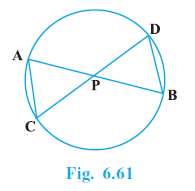
Answer:
Given:
Two chords AB and CD intersect each other at point P inside a circle.
To Prove:
(i) $\triangle$APC $\sim$ $\triangle$ DPB
(ii) AP $\cdot$ PB = CP $\cdot$ DP
Proof:
(i) To prove $\triangle$APC $\sim$ $\triangle$ DPB
Consider the triangles $\triangle$APC and $\triangle$ DPB.
In $\triangle$APC and $\triangle$ DPB:
$\angle$APC = $\angle$DPB
(Vertically opposite angles are equal)
$\angle$CAP = $\angle$CDB
(Angles in the same segment subtended by arc CB are equal)
Therefore, by AA similarity criterion,
$\triangle$APC $\sim$ $\triangle$ DPB
This proves the first part.
(ii) To prove AP $\cdot$ PB = CP $\cdot$ DP
Since $\triangle$APC $\sim$ $\triangle$ DPB (proved in part i), the ratio of their corresponding sides is equal.
The corresponding sides are opposite to the equal angles:
- Side opposite $\angle$ACP is AP, and side opposite $\angle$DBP is DP. So, $\frac{AP}{DP}$.
- Side opposite $\angle$CAP is CP, and side opposite $\angle$CDB is BP (or PB). So, $\frac{CP}{PB}$.
- Side opposite $\angle$APC is AC, and side opposite $\angle$DPB is DB. So, $\frac{AC}{DB}$.
Thus, we have the proportionality:
$\frac{AP}{DP} = \frac{CP}{PB} = \frac{AC}{DB}$
Take the first two ratios:
$\frac{AP}{DP} = \frac{CP}{PB}$
Cross-multiply the terms:
$AP \times PB = DP \times CP$
Rearranging the terms on the right side gives:
$AP \cdot PB = CP \cdot DP$
This proves the second part.
Hence Proved.
Question 8. In Fig. 6.62, two chords AB and CD of a circle intersect each other at the point P (when produced) outside the circle. Prove that
(i) ∆ PAC ~ ∆ PDB
(ii) PA . PB = PC . PD

Answer:
Given:
Two chords AB and CD of a circle, when produced, intersect each other at point P outside the circle.
To Prove:
(i) $\triangle$ PAC $\sim$ $\triangle$ PDB
(ii) PA $\cdot$ PB = PC $\cdot$ PD
Proof:
Consider the triangles $\triangle$ PAC and $\triangle$ PDB.
In $\triangle$ PAC and $\triangle$ PDB:
$\angle$APC = $\angle$DPB
(Common angle at P)
The points A, B, C, D lie on the circle, so ACBD forms a cyclic quadrilateral.
Consider the angles subtended by the arc BC at the circumference.
$\angle$BAC = $\angle$BDC
(Angles in the same segment subtended by arc BC are equal)
The angle $\angle$BAC in $\triangle$ PAC is the same as $\angle$PAC.
The angle $\angle$BDC in $\triangle$ PDB is the same as $\angle$PDB.
Therefore,
$\angle$PAC = $\angle$PDB
Now, we have two pairs of equal angles in $\triangle$ PAC and $\triangle$ PDB:
$\angle$P = $\angle$P
(Common)
$\angle$PAC = $\angle$PDB
(Angles subtended by arc BC)
Therefore, by AA similarity criterion,
$\triangle$ PAC $\sim$ $\triangle$ PDB
This proves the first part.
(i) $\triangle$ PAC $\sim$ $\triangle$ PDB is proved.
(ii) To prove PA $\cdot$ PB = PC $\cdot$ PD
Since $\triangle$ PAC $\sim$ $\triangle$ PDB (proved in part i), the ratio of their corresponding sides is equal.
Matching the corresponding vertices from the similarity statement $\triangle$ PAC $\sim$ $\triangle$ PDB:
- P corresponds to P (common angle).
- A corresponds to D (opposite to $\angle$PCA and $\angle$PBD - angles subtended by arc AD). No, A corresponds to D because $\angle$PAC = $\angle$PDB.
- C corresponds to B (opposite to $\angle$PAC and $\angle$PDB - angles subtended by arc AD). No, C corresponds to B because $\angle$PCA = $\angle$PBD.
Let's match angles correctly:
- Angle P in $\triangle$ PAC corresponds to angle P in $\triangle$ PDB.
- Angle PAC in $\triangle$ PAC corresponds to angle PDB in $\triangle$ PDB (since $\angle$PAC = $\angle$PDB).
- Angle PCA in $\triangle$ PAC corresponds to angle PBD in $\triangle$ PDB (the third angle).
So, the correspondence of vertices is P $\leftrightarrow$ P, A $\leftrightarrow$ D, C $\leftrightarrow$ B.
The ratio of corresponding sides is:
$\frac{PA}{PD} = \frac{AC}{DB} = \frac{PC}{PB}$
Taking the first and third ratios from the proportionality:
$\frac{PA}{PD} = \frac{PC}{PB}$
Cross-multiply the terms:
$PA \times PB = PD \times PC$
Rearranging the terms on the right side:
$PA \cdot PB = PC \cdot PD$
This proves the second part.
(ii) PA $\cdot$ PB = PC $\cdot$ PD is proved.
Question 9. In Fig. 6.63, D is a point on side BC of ∆ ABC such that $\frac{BD}{CD}$ = $\frac{AB}{AC}$ Prove that AD is the bisector of ∠ BAC.
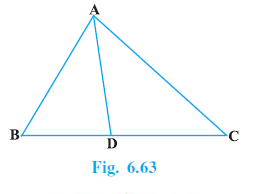
Answer:
This is a proof for the Converse of the Angle Bisector Theorem.
Given:
In $\triangle ABC$, D is a point on the side BC such that the sides are proportional as follows:
$\frac{BD}{CD} = \frac{AB}{AC}$
... (i)
To Prove:
AD is the bisector of $\angle BAC$. (i.e., $\angle BAD = \angle CAD$)
Construction Required:
Extend the side BA to a point E such that $AE = AC$. Join CE.
Proof:
We start with the given proportion from (i):
$\frac{BD}{CD} = \frac{AB}{AC}$
By our construction, we have $AE = AC$. We can substitute AE in place of AC in the proportion:
$\frac{BD}{CD} = \frac{AB}{AE}$
... (ii)
Now, consider the larger triangle $\triangle BCE$. In this triangle, the line segment AD divides the sides BC and BE in the same ratio, as shown in equation (ii).
By the Converse of the Basic Proportionality Theorem (Thales' Theorem), if a line divides two sides of a triangle in the same ratio, then the line is parallel to the third side.
Therefore, we can conclude that:
AD \parallel CE
Since $AD \parallel CE$, we can use the properties of angles formed by transversals.
If we consider BE as the transversal intersecting the parallel lines AD and CE:
$\angle BAD = \angle AEC$
[Corresponding Angles] ... (iii)
If we consider AC as the transversal intersecting the parallel lines AD and CE:
$\angle CAD = \angle ACE$
[Alternate Interior Angles] ... (iv)
Now, let's look at the triangle $\triangle ACE$ that we constructed.
By construction, $AE = AC$. Since two sides of $\triangle ACE$ are equal, it is an isosceles triangle.
In an isosceles triangle, the angles opposite to the equal sides are also equal.
$\angle AEC = \angle ACE$
... (v)
By comparing equations (iii), (iv), and (v), we can see that:
$\angle BAD = \angle AEC$
$\angle CAD = \angle ACE$
And $\angle AEC = \angle ACE$.
This implies that $\angle BAD = \angle CAD$.
Since AD divides $\angle BAC$ into two equal angles, AD is the bisector of $\angle BAC$.
Hence Proved.
Question 10. Nazima is fly fishing in a stream. The tip of her fishing rod is 1.8 m above the surface of the water and the fly at the end of the string rests on the water 3.6 m away and 2.4 m from a point directly under the tip of the rod. Assuming that her string (from the tip of her rod to the fly) is taut, how much string does she have out (see Fig. 6.64)? If she pulls in the string at the rate of 5 cm per second, what will be the horizontal distance of the fly from her after 12 seconds?
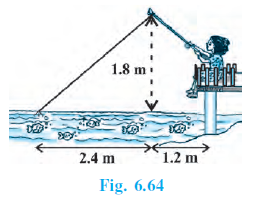
Answer:
Given:
Height of the tip of the fishing rod above the water = $1.8$ m.
Initial horizontal distance of the fly from the point under the rod tip = $2.4$ m.
Initial horizontal distance of the fly from Nazima = $3.6$ m.
Rate at which the string is pulled in = $5$ cm/s.
To Find:
(i) The initial length of the string she has out.
(ii) The horizontal distance of the fly from her after 12 seconds.
Solution:
Let's represent the situation with a diagram.
Let T be the tip of the rod, P be the point on the water directly under the tip, and F be the initial position of the fly. Let N be Nazima's position on the bank.
Part (i): Finding the initial length of the string
The setup forms a right-angled triangle $\triangle TPF$.
The height of the tip of the rod, $TP = 1.8$ m.
The horizontal distance, $PF = 2.4$ m.
The length of the string is the hypotenuse, $TF$.
By the Pythagorean theorem in the right-angled triangle $\triangle TPF$:
$TF^2 = TP^2 + PF^2$
Substitute the given values:
$TF^2 = (1.8)^2 + (2.4)^2$
$TF^2 = 3.24 + 5.76$
$TF^2 = 9.00$
$TF = \sqrt{9} = 3$
So, the initial length of the string she has out is 3 m.
Part (ii): Finding the new horizontal distance after 12 seconds
First, calculate the length of the string pulled in over 12 seconds.
Rate = $5$ cm/s, Time = $12$ s.
Length pulled in = Rate $\times$ Time = $5 \text{ cm/s} \times 12 \text{ s} = 60$ cm.
Convert this length to meters: $60 \text{ cm} = 0.6$ m.
Now, calculate the new length of the string out.
New string length = Initial length - Length pulled in = $3 \text{ m} - 0.6 \text{ m} = 2.4$ m.
After 12 seconds, the fly has moved to a new position, let's call it F'. The setup forms a new right-angled triangle $\triangle TPF'$.
The height remains the same: $TP = 1.8$ m.
The new hypotenuse (string length) is $TF' = 2.4$ m.
We need to find the new horizontal distance from the point under the rod tip, $PF'$.
By the Pythagorean theorem in $\triangle TPF'$:
$(TF')^2 = TP^2 + (PF')^2$
$(2.4)^2 = (1.8)^2 + (PF')^2$
$5.76 = 3.24 + (PF')^2$
$(PF')^2 = 5.76 - 3.24 = 2.52$
$PF' = \sqrt{2.52}$ m.
The question asks for the horizontal distance of the fly from Nazima (N).
The horizontal distance from Nazima to the point under the rod tip (NP) is:
$NP = NF - PF = 3.6 \text{ m} - 2.4 \text{ m} = 1.2$ m.
This distance is constant. The final horizontal distance of the fly from Nazima is the sum of this constant distance and the new horizontal distance of the fly from the point under the rod tip ($PF'$).
Final horizontal distance from Nazima = $NP + PF'$
Final horizontal distance = $1.2 + \sqrt{2.52}$ m.
To approximate the value: $\sqrt{2.52} \approx 1.587$ m.
Final horizontal distance $\approx 1.2 + 1.587 = 2.787$ m.
The horizontal distance of the fly from her after 12 seconds will be $1.2 + \sqrt{2.52}$ m (approximately $2.79$ m).

